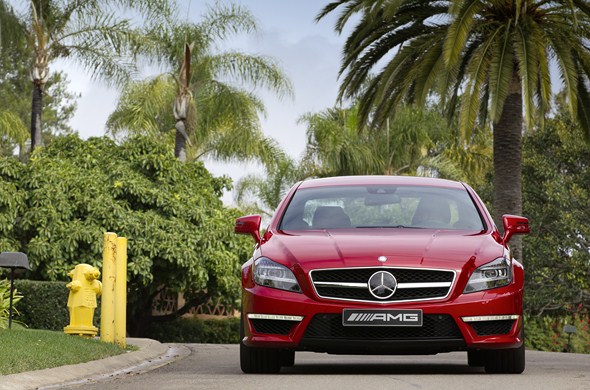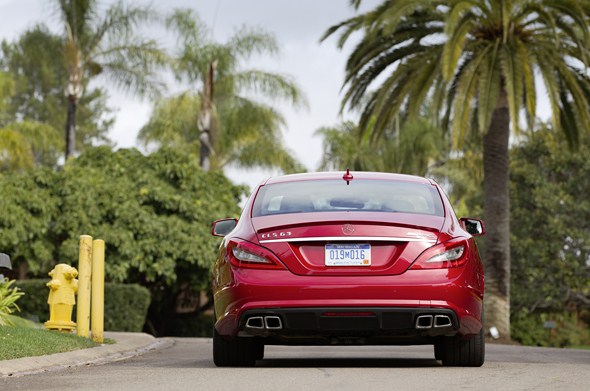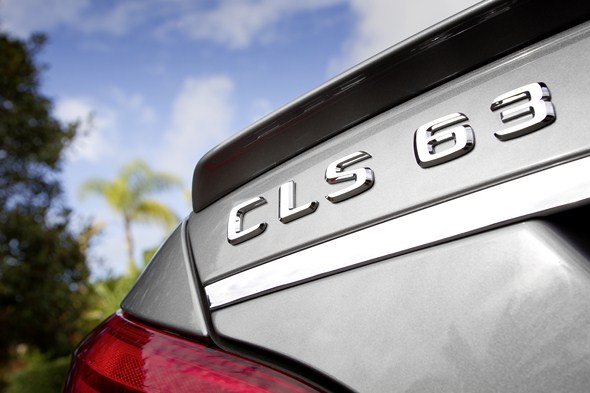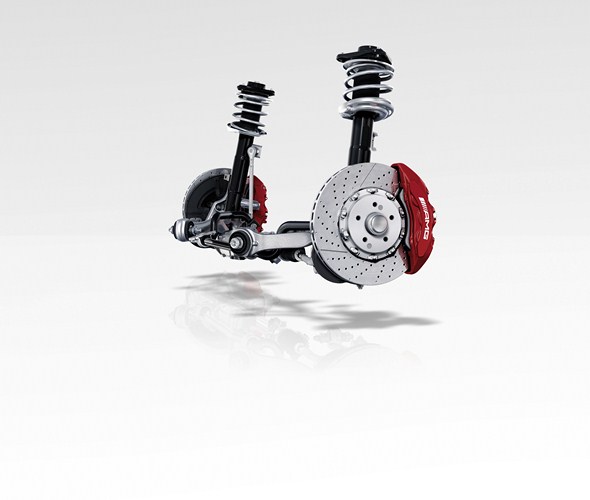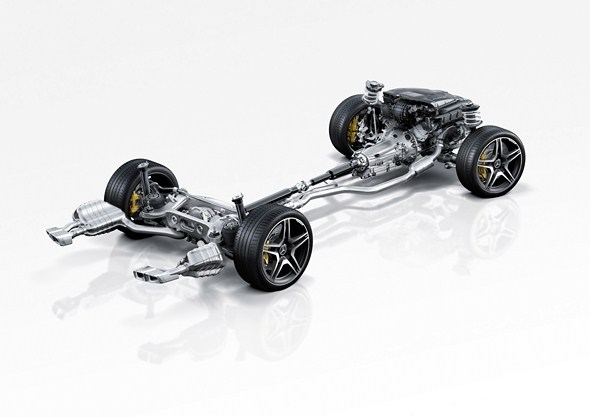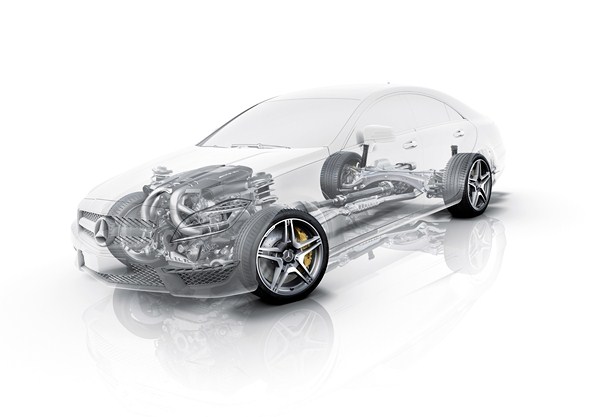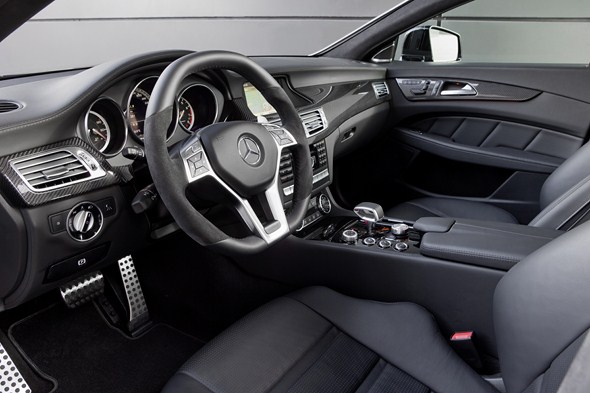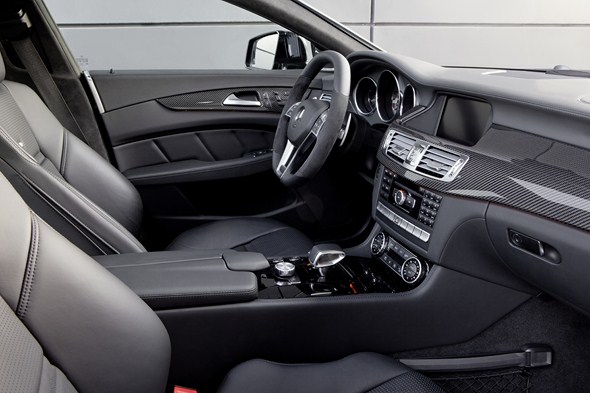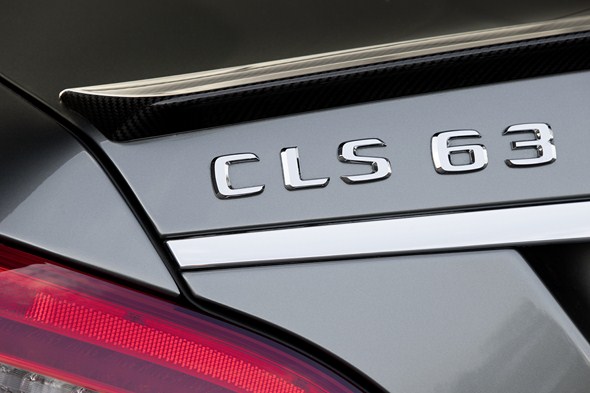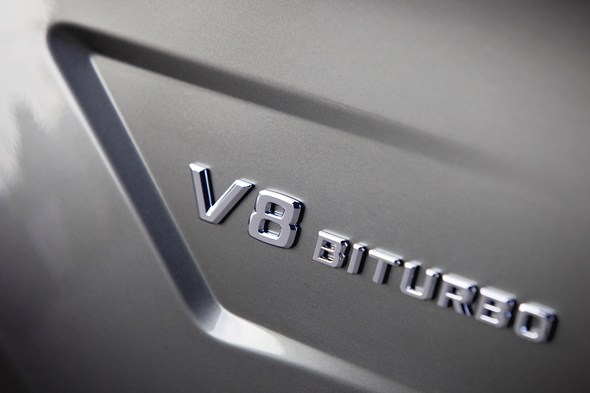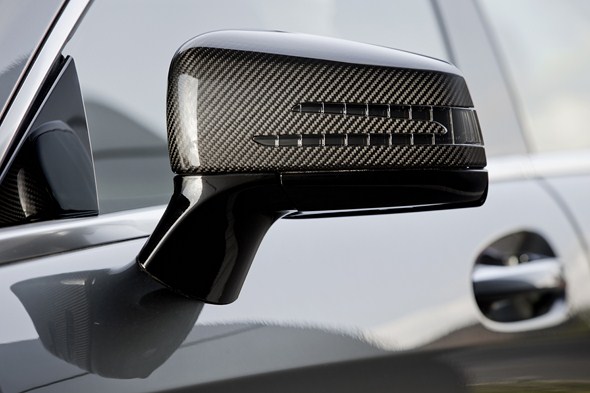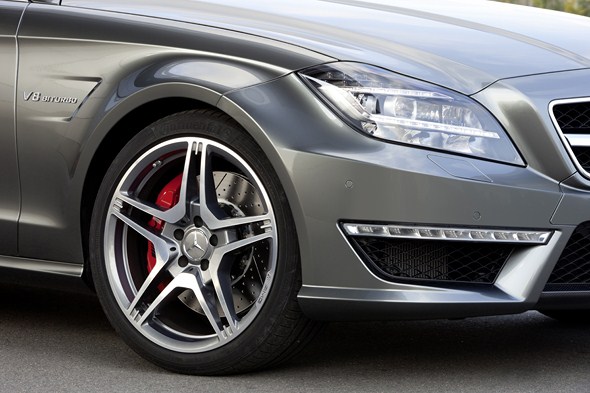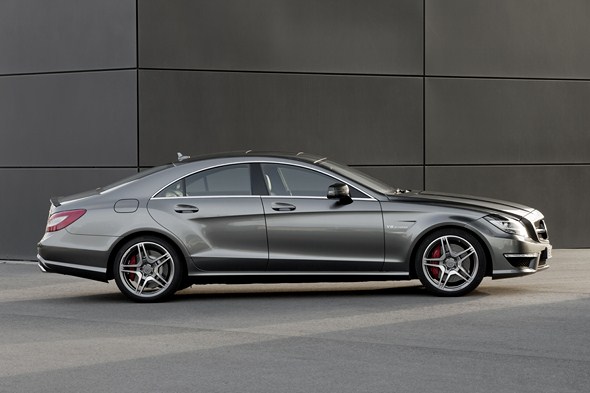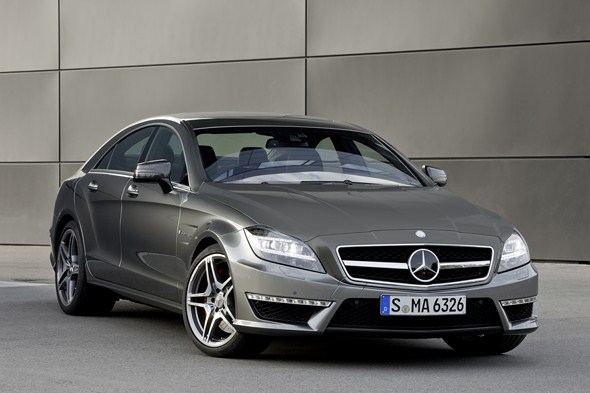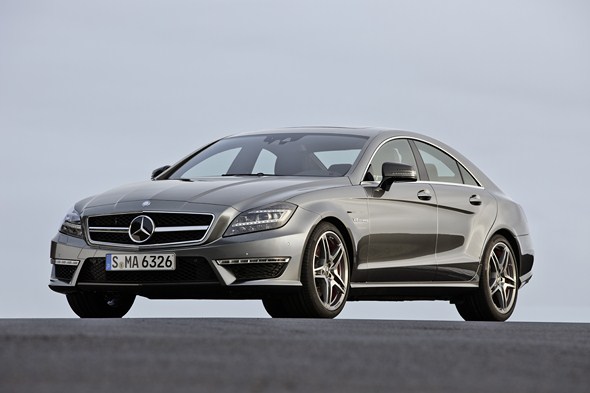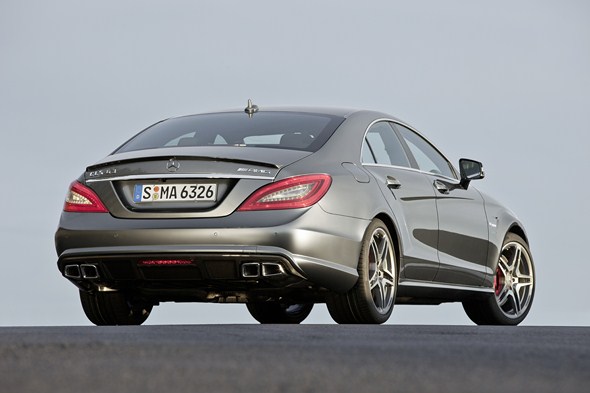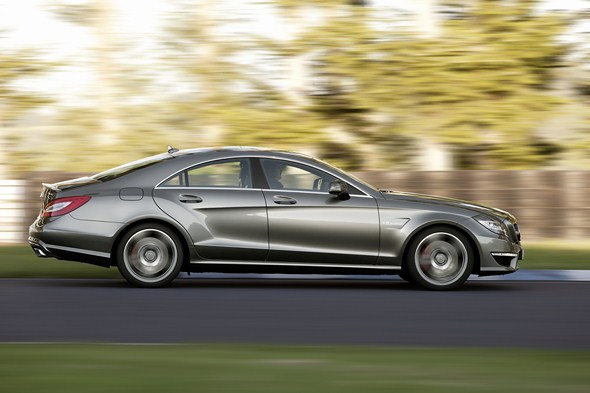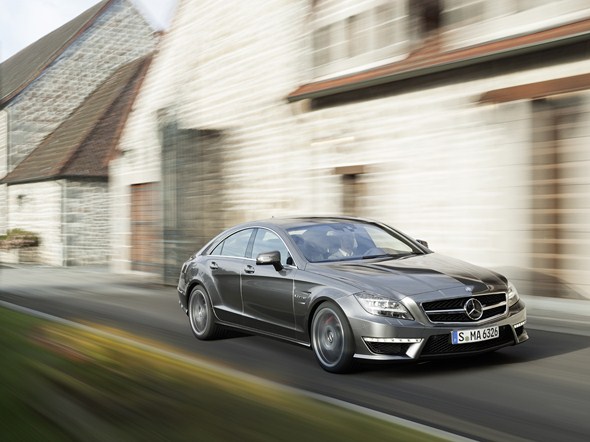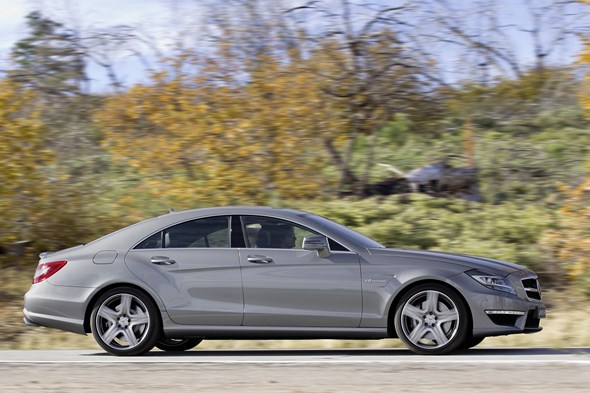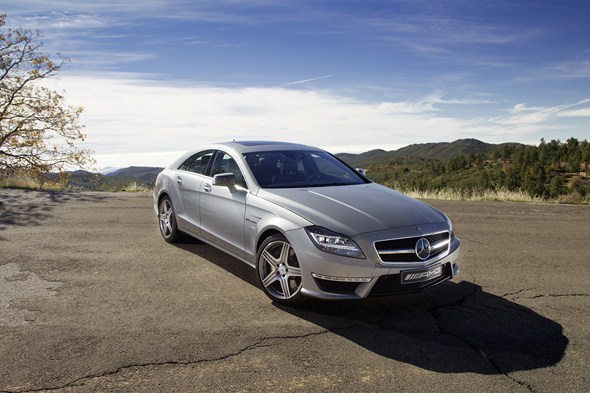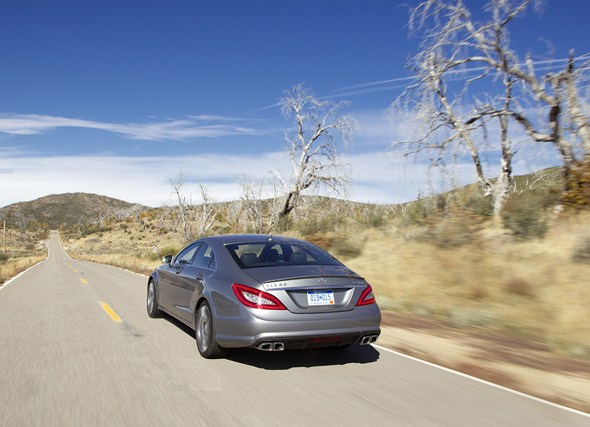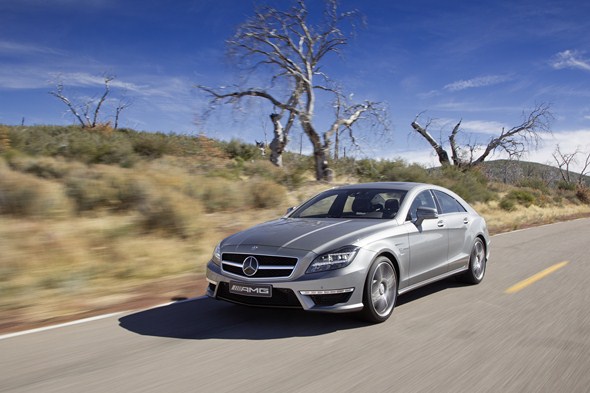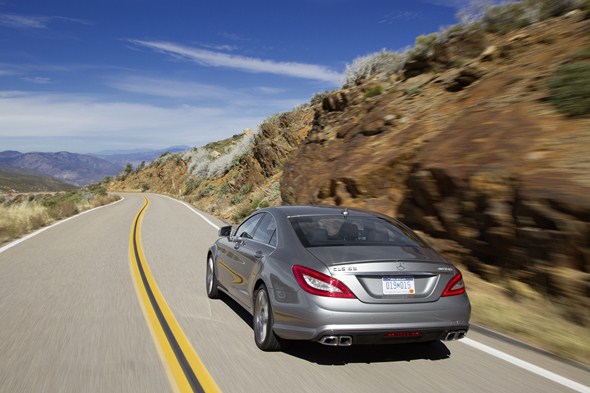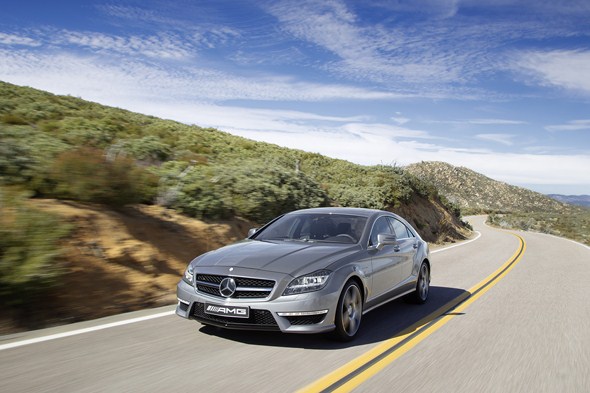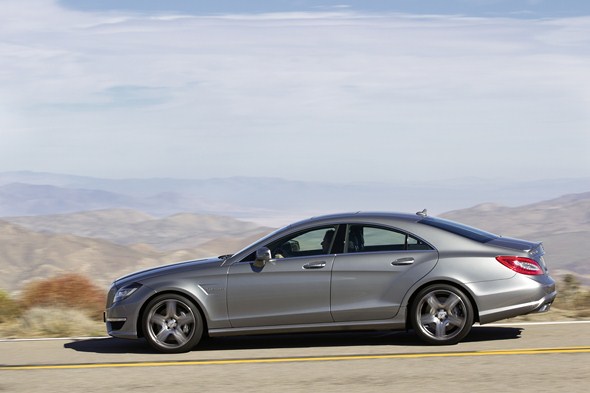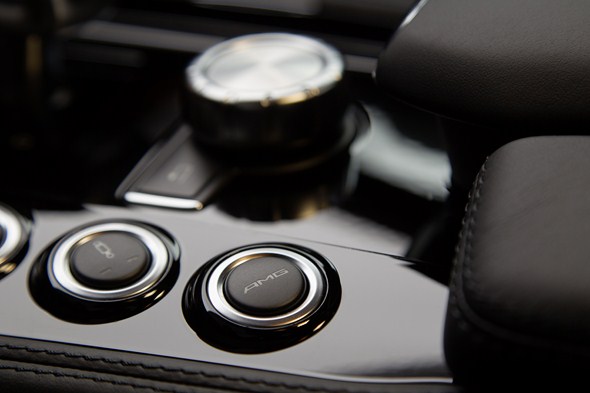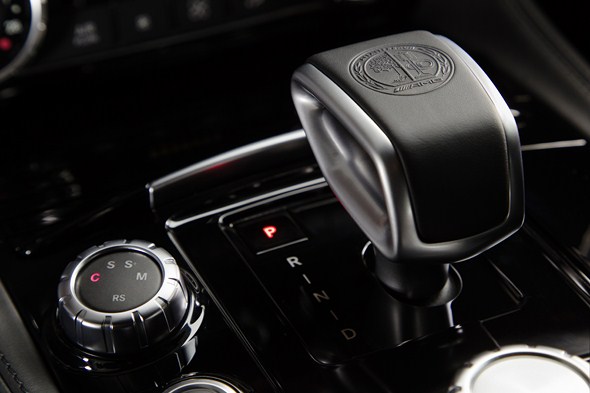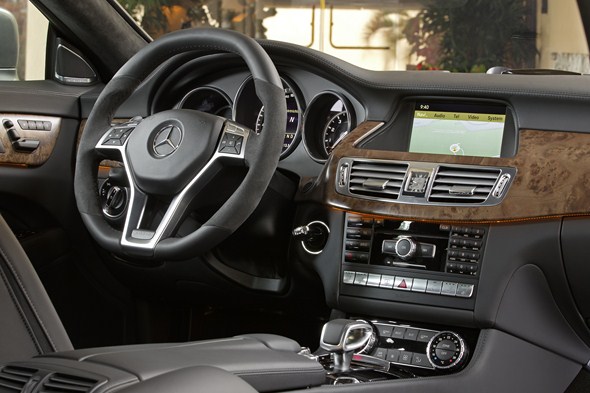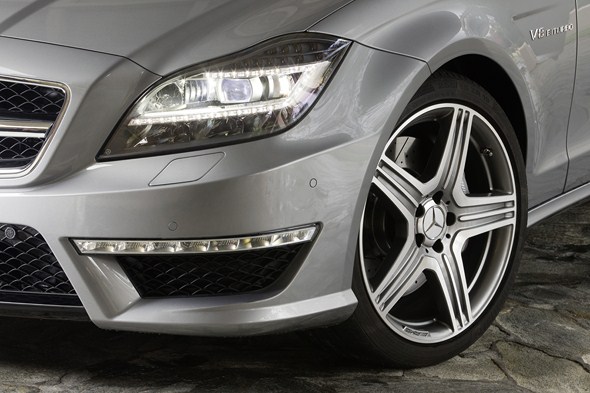AMG V8 biturbo engine consuming 9.9 litres per 100 km

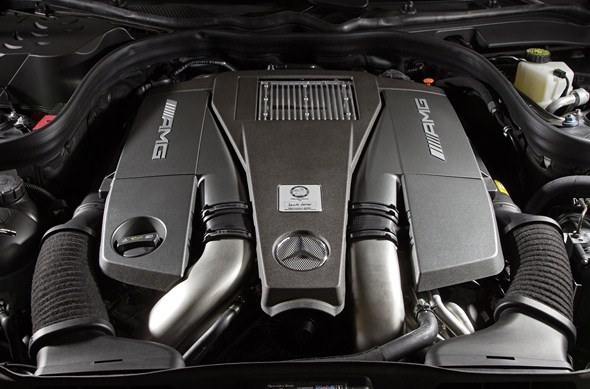
CLS 63 AMG – the benchmark in design, performance and efficiency

Affalterbach – Exciting design, ultimate performance and groundbreaking efficiency: this is what the new Mercedes-Benz CLS 63 AMG is all about. The top-of-the-range version of the four-door coupé is equipped with the newly developed AMGV8 biturbo engine, featuring a peak output of up to 410 kW (557 hp) and 800 Nm of torque, as well as the AMG SPEEDSHIFT MCT 7-speed sports transmission. On top of this, the vehicle’s fuel consumption of 9.9 litres per 100 km (NEDC) represents an improvement of 32 percent compared with the previous model (all figures provisional).
The combination of an AMG RIDE CONTROL sports suspension with electronically controlled damping system and new front axle, newly developed electromechanical AMG sports parameter steering, and also optional AMG ceramic high-performance composite braking system, is synonymous with maximum driving dynamics. Visually, the CLS 63 AMG impresses with its athletic appearance and distinctive exterior and interior design.
The model’s standard specification also includes innovative LED High Performance headlamps.
“The new CLS 63 AMG continues the success story of the previous models, the CLS 55 AMG and CLS 63 AMG, which have delighted our customers all around the world since 2004”, according to Ola Källenius, Head of Mercedes-AMG GmbH. “The CLS 63 AMG is a unique high-performance car – it sets new standards in design, performance and efficiency.”

Like the S 63 AMG and CL 63 AMG, drivers of the CLS 63 AMG will benefit from an eight-cylinder powerhouse, designated internally as the M 157: the new AMG 5.5-litre V8 biturbo engine boasts a combination of innovative high-tech components which, in addition to spray-guided direct petrol injection with piezo injectors, also include a full aluminium crankcase, four-valve technology with camshaft adjustment, air/water intercooling, generator management and stop/start system.
With a displacement of 5461 cc, the eight-cylinder engine develops a peak output of 386 kW (525 hp) and torque of 700 Nm. In conjunction with the AMG Performance package, these figures increase to 410 kW (557 hp) and 800 Nm. Both variants of the CLS 63 AMG achieve exceptional performance: acceleration from zero to 100 km/h takes 4.4 and 4.3 seconds respectively, and the top speed is 250 km/h (electronically limited).
The major difference between both power units is the increase in the maximum charge-air pressure from 1.0 to 1.3 bar. In addition, the CLS 63 AMG with the AMGPerformance package features a special high-quality carbon fibre engine cover.
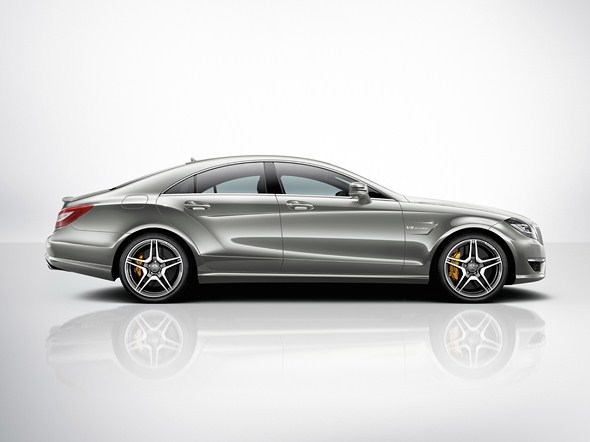
Quantum leap: fuel consumption reduced by 32 percent
Despite a significant performance increase compared with the previous model, which had a naturally aspirated AMG 6.3-litre V8 engine producing 378 kW (514 hp) and 630 Nm of torque, the new CLS 63 AMG is some 4.6 litres, or 32 percent, more economical – which represents a quantum leap forward.
The NEDC fuel consumption of 9.9 litres per 100 km equates to a CO2 output of 232 g/km. Thanks to these figures, the new V8 Coupé from AMG not only undercuts all of its direct competitors in the small but refined four-door high-performance coupé segment, but is also more fuel efficient than significantly lower-powered vehicles. Both performance variants have identical fuel consumption and CO2 figures.
Key data at a glance:
| CLS 63 AMG | |
| Displacement | 5461 cc |
| Bore x stroke | 98.0 x 90.5 mm |
| Compression ratio | 10.0:1 |
| Output | 386 kW (525 hp) at 5250 rpm 410 kW (557 hp) at 5750 rpm* |
| Max. torque | 700 Nm at 1750 – 5000 rpm 800 Nm at 2000 – 4500 rpm* |
| Engine weight (dry) | 204 kg |
| Fuel consumption NEDC combined | 9.9 l/100 km |
| CO2 emissions | 232 g/km |
| Acceleration 0 – 100 km/h | 4.4 s4.3 s* |
| Top speed** | 250 km/h |
All figures are provisional; * with AMG Performance package; ** electronically limited
Exclusive: AMG SPEEDSHIFT MCT 7-speed sports transmission
A major contribution towards achieving the unrivalled consumption figures has been made by the AMG SPEEDSHIFT MCT 7-speed sports transmission, a component used exclusively at Mercedes-AMG. Unlike a conventional automatic transmission, the MCT transmission does away with the torque converter; instead, it makes use of a compact, wet start-up clutch.
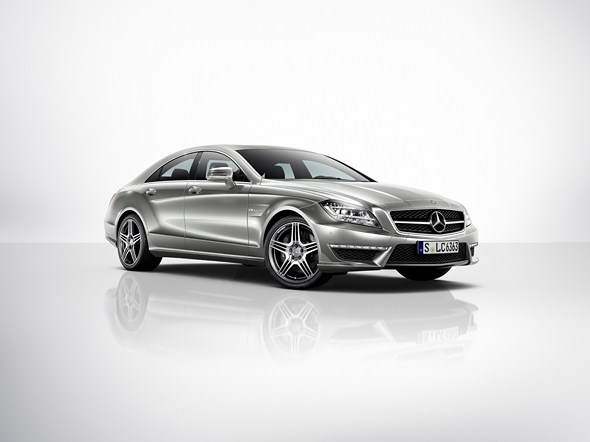
Also fitted as standard equipment is the stop/start function: it is permanently active in the transmission’s Controlled Efficiency (“C”) mode, and switches the eight-cylinder engine off when the car comes to a stop. At the same time, “C” mode also means a “soft” accelerator response set-up with convenient and early gearshifts; moving off generally takes place in second gear. A green “ECO” symbol in the AMG instrument cluster shows the driver that the stop/start function is active.
The engine and transmission come across as much more agile in the “S” (Sport), “S+” (Sport plus) and “M” (Manual) modes; in addition, the stop/start function is switched off. In “S” and “M” modes, the engine management system partially suppresses the cylinders: interrupting ignition and injection under full load leads to even faster gearshifts than before. The highly emotional vocals are an appealing side effect of this lightning-fast process. An automatic double-declutching function and RACE START function are also included as standard.
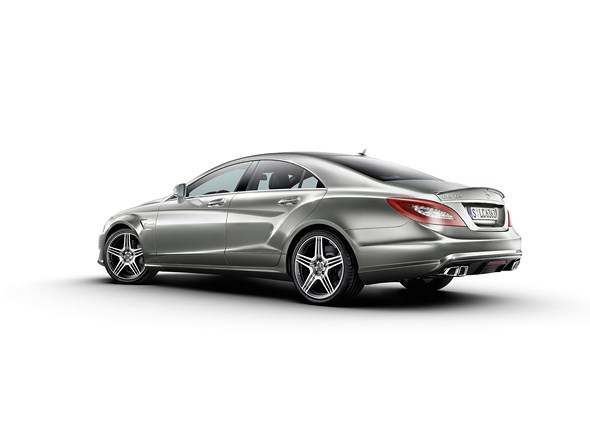
Autonomously developed AMG RIDE CONTROL sports suspension
The suspension, steering and braking system of the new CLS 63 AMG complement the high-tech drive system perfectly. The AMG RIDE CONTROL sports suspension, with steel suspension struts on the front axle and air suspension struts on the rear axle, as well as automatic level control, is enhanced further by an electronically controlled damping system; it automatically adjusts the damping characteristics depending on the driving conditions and reduces the roll angle of the body.
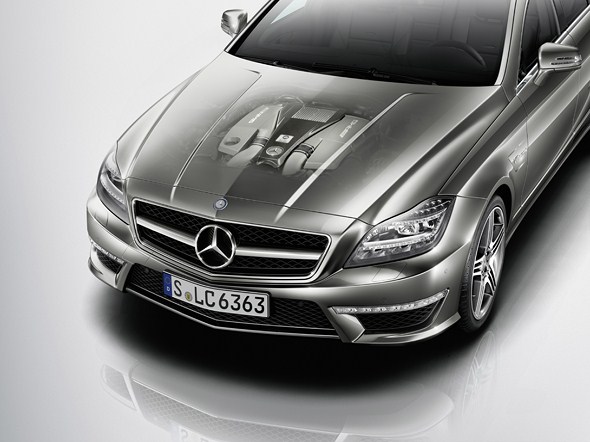
The result: lightning-fast adjustment between optimum driving comfort and the best possible agility. The driver can switch between the three suspension modes of “Comfort”, “Sport” and “Sport plus” at the press of a button.
The autonomously developed front axle, with a track width which is 24 mm wider, is the perfect match for the newly developed electromechanical AMG sports parameter steering. It not only features variable power assistance which adapts according to the suspension mode, but also contributes towards reducing fuel consumption by up to 0.3 litre (7 g CO2) in the ECE fuel cycle, since the steering assistance system only draws power when the vehicle is actually being steered. The 3-stage ESP® also has individual setting options – thereby providing a definite advantage when it comes to combining driving pleasure with absolute driving safety.
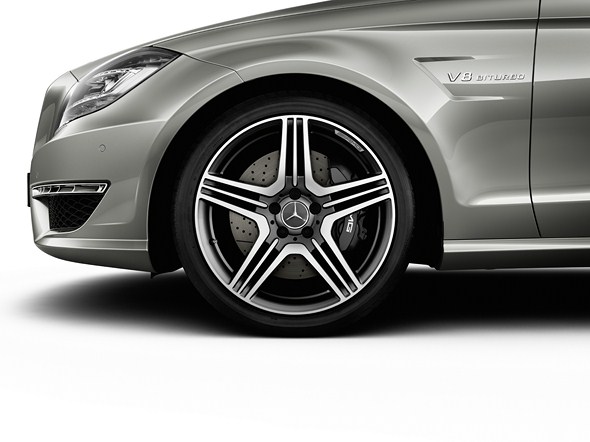
AMG ceramic high-performance composite braking system available as an option
Perfect deceleration even when driving extremely briskly is ensured by the AMG high-performance braking system with 360 mm, internally ventilated and perforated brake discs all-round. Particularly resistant, motorsports-tested composite technology is used on the front axle.
The optional AMG ceramic high-performance composite braking system with yet larger brake discs guarantees an even higher level of braking performance as well as lower unsprung masses.
Good contact with the road, meanwhile, is provided courtesy of the titanium grey-painted, high-sheen AMG light-alloy wheels featuring a new triple-spoke design and fitted with 255/35 R 19 tyres on the front and 285/30 R 19 tyres on the rear.
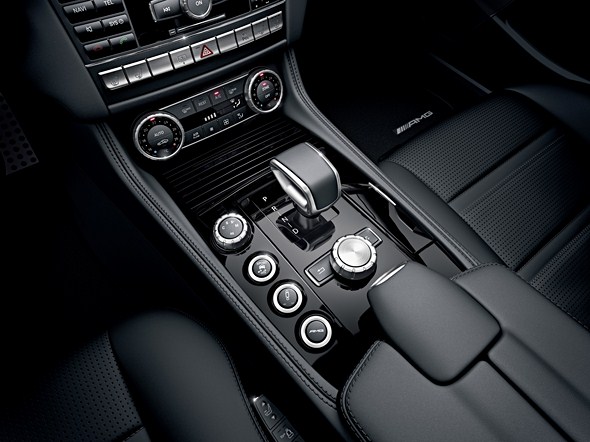
Intelligent lightweight construction: making a significant contribution to efficiency
The highest level of engineering is also reflected in the body of the new CLS 63 AMG: the intelligent lightweight construction makes a significant contribution towards addressing the classic conflicting goals of low weight and
high strength.
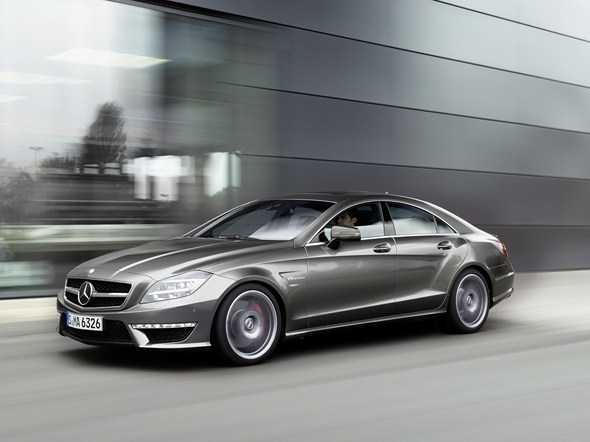
Like the SLS AMG, the CLS 63 AMG is also fitted with doors featuring a full aluminium construction. They consist of deep-drawn aluminium panels with extruded sections, and are around 24 kg lighter compared with conventional steel doors. In addition, the bonnet, front wings, boot lid, parcel shelf, various support sections as well as major parts of the chassis and engine are all made from aluminium too.
Light-years ahead: LED High Performance headlamps as standard
The CLS 63 AMG is the first passenger car in the world to offer LED High Performance headlamps, which combine the exciting colour elements of LED technology – similar to those of daytime running lamps – with the performance, functionality and energy efficiency of today’s bi-xenon generation.
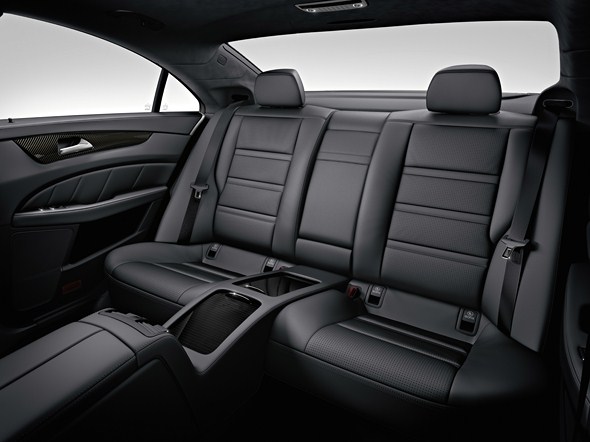
Fitted as standard, for the first time ever this new light system provides the Intelligent Light System already proven in Mercedes models fitted with bi-xenon headlamps in combination with LED technology. The headlamps, with their 71 LED lamps in total, underline the unmistakable appearance of the CLS 63 AMG.
The light specialists from Mercedes-Benz have for the first time been able to use LED technology in the Adaptive Highbeam Assist, resulting in an entirely new level of safety when driving at night.
In contrast to the first vehicles equipped with LED headlamps, no compromises are now necessary with respect t o the functionality and performance of the lighting technology. There are further arguments for the new, LED-based lighting technology: the average operating life of an LED is around 10,000 hours, around five times longer than that of a xenon light; moreover, LED headlamps most closely approximate the colour temperature of daylight.
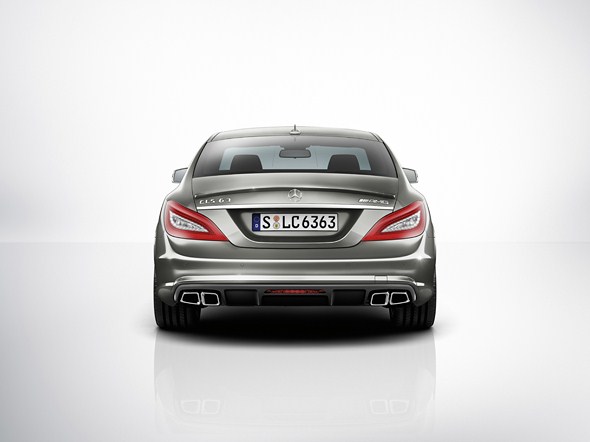
This means that LED light is in keeping with normal human perception patterns. Studies have shown that the closer the colour of artificial light comes to daylight, the less strain there is on the eyes. With a colour temperature of 5500 kelvin, LED light is closer to daylight (6500 K) than xenon light (4200 K). The LED daytime driving lights specific to AMG are also presented in two characteristic light strips integrated into the
AMG front apron.
Exterior design inspired by the SLS AMG
When viewed from the front, the new CLS 63 AMG evokes associations with the SLS AMG – the radiator grille in particular, with its large Mercedes star and wing-shaped horizontal slats, appears to have been inspired by the gullwing.
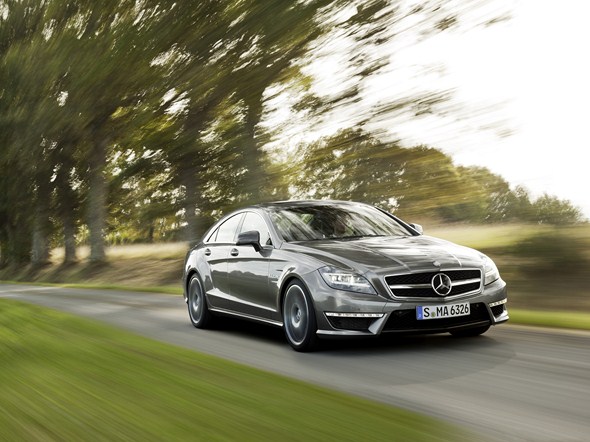
The top-of-the-range AMG model distinguishes itself from the other CLS variants with its distinctive bonnet, wider mudguards with “V8 BITURBO” logo and a specific AMG front apron with black painted cross member.
Eye-catching features at the rear include the diffuser insert, the AMG spoiler lip on the boot lid, the AMG sports exhaust system with dual twin chrome tailpipes, and – as also featured on the SLS AMG – integrated rear foglamp.
The AMG bodystyling perfectly matches the typical CLS outline, which is essentially characterised by the elegantly long proportions, the lateral dropping line and the muscular sports car-like shoulder line above the rear axle.
Exclusive atmosphere in the interior
This philosophy also continues through consistently into the interior. All of the AMG-specific design and appointment features ideally supplement the redesigned CLS interior. The wrap-around effect in the cockpit, with its high line which sweeps from the driver’s door over the instrument panel support and across to the front passenger door, is generously flanked by high-quality trim elements – available in black piano lacquer as standard in the top-of-the-range AMG model. Quality materials and workmanship meet the very highest of standards and help to guarantee a particularly exclusive atmosphere.
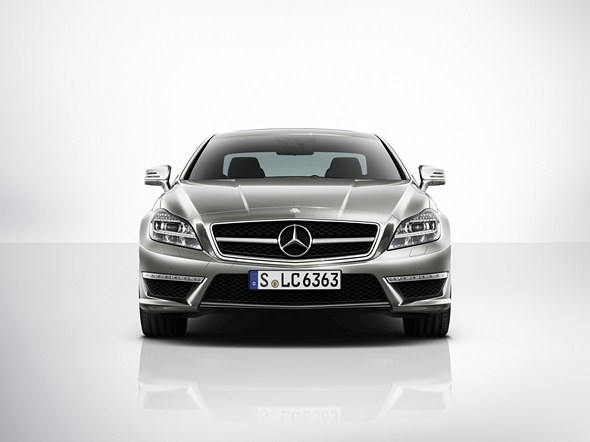
The extensive range of standard appointments also includes AMG sports seats in nappa leather, a new three-spoke AMG Performance steering wheel with aluminium shift paddles and flattened top and bottom sections, and the AMG DRIVE UNIT with compact E-SELECT selector lever.
New driving assistance systems: greater safety
More than a dozen driving assistance systems on the new CLS help to prevent traffic accidents and reduce the severity of an accident. The Active Blind Spot Assist and the Active Lane Keeping Assist are new.
Active Blind Spot Assist warns the driver if it detects – with the assistance of short-range radar sensors – that there is a danger of collision if the vehicle is about to change lanes.
Should the driver ignore the warnings and come dangerously close to the vehicle in the next lane, Active Blind Spot Assist will intervene. By applying braking force to the wheels on the opposite side of the vehicle via the Electronic Stability Program ESP®, a yaw movement is created which counteracts the collision course.
Active Lane Keeping Assist is now also linked to the ESP® for the first time. This system kicks into action if the driver inadvertently drifts over a solid line to the right or left of a lane. In this case, Active Lane Keeping Assist brakes the opposite wheels and thereby prevents the vehicle from crossing the line. A display on the instrument cluster warns the driver at the same time. If broken lane markings are crossed, the system controls an electric pulse generator in the steering wheel which generates vibrations for a short time – a discreet but highly effective cue to countersteer immediately. Before the braking system intervenes, the steering wheel always vibrates to provide a warning.
AMG Performance package with enhanced performance ex works
One of the highlights of the attractive optional extras is the AMG Performance package which is available for the CLS 63 AMG. It comprises:
- · an increase in the peak output of 24 kW (32 hp) and in the maximum torque of 100 Nm; genuine carbon fibre AMG engine cover
- · genuine carbon fibre AMG spoiler lip on the boot lid
- · red-painted brake calipers
- · AMG Performance steering wheel with Alcantara® inserts in the grip areas
Exclusive optional extras are also available from the AMG Performance Studio:
- · AMG RIDE CONTROL Performance suspension
- · Lightweight, forged AMG light-alloy wheels featuring a 5-twin-spoke design with size 255/35 R 19 tyres at the front and 285/30 R 19 at the rear
- · AMG rear axle locking differential with 40 percent locking action
- · AMG ceramic high-performance composite braking system
- · AMG Exterior Carbon package
- · AMG trim elements in carbon fibre/black piano lacquer
- · Illuminated AMG door sill panels
- · AMG Driver’s Package (includes restriction of top speed to 300 km/h, participation in driver training course at the AMG Driving Academy)
Specially designed “Edition 1”
Also available is the special limited “Edition 1” version of the CLS 63 AMG. Finished in the new manganite grey SHAPE matt paint, the “Edition 1” features a host of specially designed high-quality interior details. On opening the doors, the first items to catch the eye are the AMG sports seats: the “corteccia pearl” designo leather is characterised by a shimmering metallic surface finish.
The roof lining, A, B and C-pillars, as well as the sunblinds, are finished in anthracite Alcantara®, while carbon fibre/black piano lacquer AMG trim elements help to give the interior a functional atmosphere. Also making a perfect match for the designo leather seats are the designo floormats in black velour, featuring designo badge and designo leather insert in “corteccia pearl”.
The market launch of the new CLS 63 AMG will commence in March 2011.
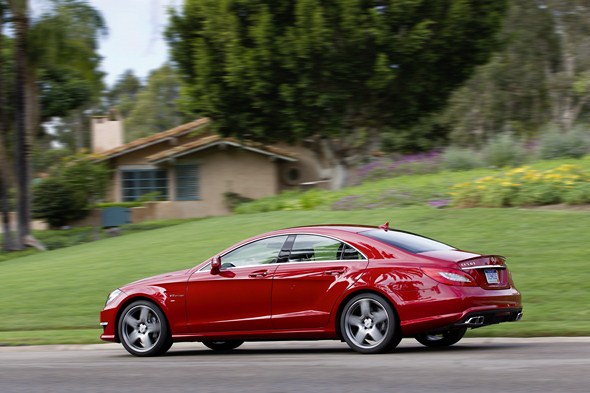
AMG 5.5-litre V8 biturbo engine
Unique high-tech features for superior driving pleasure
A new AMG high-performance engine is expected to deliver maximum performance in all areas – and the AMG 5.5-litre V8 biturbo engine driving the new CLS 63 AMG is no exception to this rule. Whether its maximum performance, torque and power delivery, engine sound, suitability for long journeys or renowned Mercedes reliability, the powerful 410 kW (557 hp) eight-cylinder engine is able to meet all of the demands which are made
of it. Future challenges also include being able to achieve optimum values when it comes to efficiency too, however.
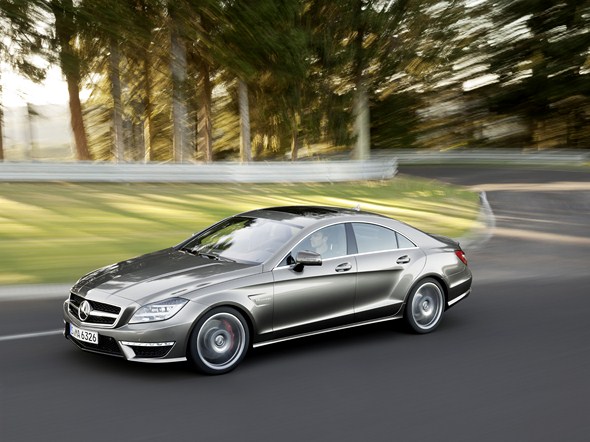
Here again the CLS 63 AMG is setting standards, as evidenced by its fuel consumption of 9.9 litres per 100 kilometres (NEDC combined).
As such the performance Coupé demonstrates how exciting dynamism and low fuel consumption can be combined to impressive effect. This is made possible by a unique combination of innovative high-tech systems such as direct petrol injection, twin turbochargers, air/water intercooling and the stop/start function.
Mercedes-AMG is systematically following the trend towards increasing efficiency with its V8 biturbo engine: with a displacement of 5461 cubic centimetres it is precisely 747 cc below the 6208 cc of the naturally aspirated AMG 6.3-litre V8. Nonetheless it considerably betters it in terms of output and torque.
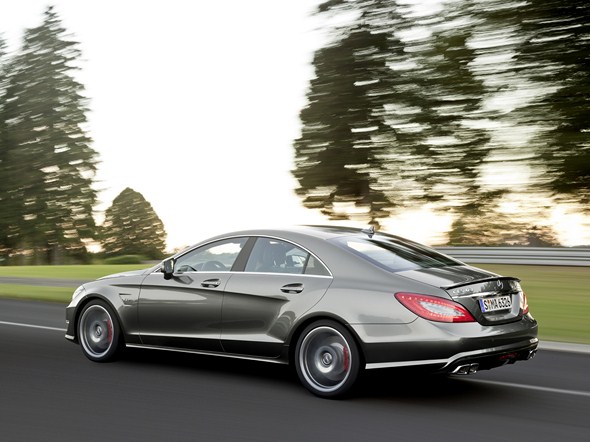
It develops a peak output of 386 kW (525 hp) and maximum torque of 700 Nm. In conjunction with the AMG Performance Package these figures increase to 410 kW (557 hp) and 800 Nm.
Despite an increase in output of 8 kW (11 hp) and 32 kW (43 hp) respectively, and in torque of 70 and 170 Nm compared to the naturally aspirated V8, which develops 378 kW (514 hp) and 630 Nm, AMG engineers have been able to reduce fuel consumption and CO2 emissions considerably. With an NEDC fuel consumption of only 9.9 litres per 100 kilometres, the new CLS 63 AMG betters its predecessor by 4.6 litres.
This equates to a fuel saving of more than 32 percent, which engine specialists consider to be nothing less than a quantum leap. CO2 emissions have likewise been significantly reduced: at 231 grams per kilometre, the figure is almost 32 percent lower than for the previous model (345 g/km). Both engine variants achieve identical consumption and emissions values. Thanks to the increased efficiency, it has been possible to reduce the volume of the fuel tank from its previous 80 litres to 66 litres. An 80-litre tank is also optionally available at no extra cost.
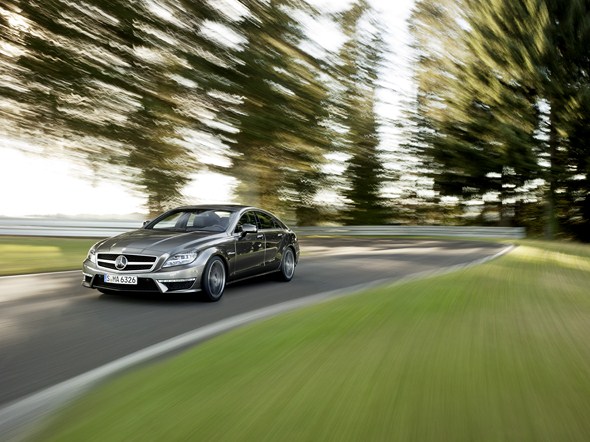
The achievement of these efficiency and environmental aims has no negative effects whatsoever on dynamic performance. On the contrary, as the new AMG 5.5‑litre V8 biturbo fully lives up to AMG’s brand commitment to “performance”: the CLS 63 AMG accelerates from zero to 100 km/h in 4.4 seconds, and with the AMG Performance package the Coupé reaches the 100 km/h mark in 4.3 seconds. The top speed of both engine variants is 250 km/h (electronically limited).
Key data at a glance:
|
| CLS 63 AMG | CLS 63 AMG with AMG Performance package |
| Cylinder arrangement | V8 | V8 |
| Cylinder angle | 90° | 90° |
| Valves per cylinder | 4 | 4 |
| Displacement | 5461 cc | 5461 cc |
| Bore x stroke | 98.0 x 90.5 mm | 98.0 x 90.5 mm |
| Cylinder spacing | 106 mm | 106 mm |
| Compression ratio | 10.0:1 | 10.0:1 |
| Output | 386 kW (525 hp) at 6800 rpm | 410 kW (557 hp) at 5750 rpm |
| Output per litre | 71 kW (96 hp) | 75 kW (102 hp) |
| Max. torque | 700 Nm at 1750 – 5000 rpm | 800 Nm at 2000 – 4500 rpm |
| Torque per litre | 128 Nm | 146 Nm |
| Maximum engine speed | 6400 rpm | 6400 rpm |
| Mean pressure | 18.5 bar | 20.8 bar |
| Engine weight (dry) | 204 kg | 204 kg |
| Power/weight ratio | 0.39 kg/hp | 0.36 kg/hp |
| Fuel consumptionNEDC combined | 9.9 l/100 km | 9.9 l/100 km |
| CO2 emissions | 231 g/km | 231 g/km |
| Acceleration 0 – 100 km/h | 4.4 s | 4.3 s |
| Top speed | 250 km/h* | 250 km/h* |
* electronically limited.
Combination of twin turbocharging and direct petrol injection
Mercedes-AMG is presenting an attractive high-tech package with its combination of biturbo charging and direct petrol injection with spray-guided combustion. The innovative injection technology brings decisive advantages with respect to fuel consumption and exhaust emissions, thanks to higher thermodynamic efficiency.
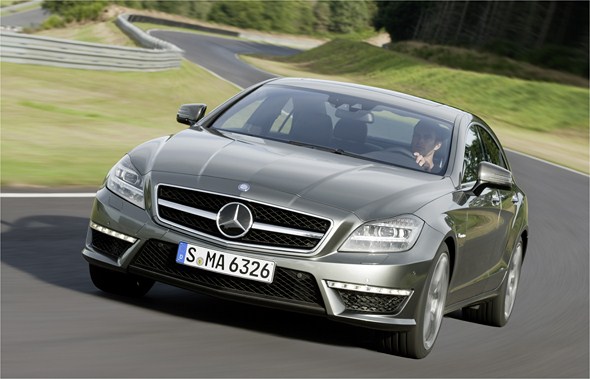
Particularly fast and precise piezo-electric injectors spray the fuel into the combustion chambers, ensuring a particularly fine distribution of the fuel droplets into the air in the combustion chamber. The result is highly effective combustion.
An electric low-pressure pump delivers the fuel from the tank to a high-pressure pump in the boot with a pressure of six bar. The fuel pressure in the high-
pressure rail is controlled between 100 and 200 bar on a fully variable and demand-related basis.
Two exhaust gas turbochargers and efficient air/water intercooling
Two exhaust gas turbochargers located next to the cylinder banks supply the eight cylinders with fresh air. At their maximum speed of 185,000 rpm under full load, the two turbochargers force 1750 kg of air into the combustion chambers per hour.
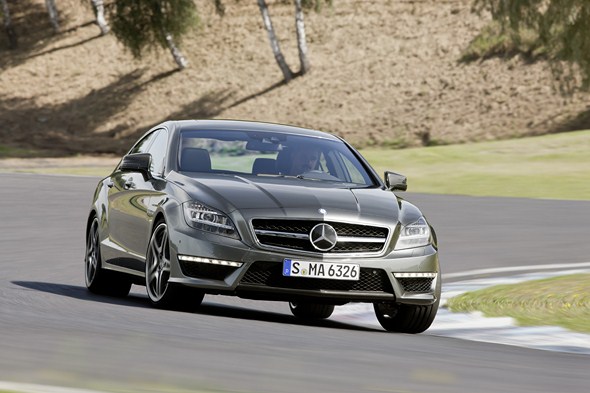
The maximum charge pressure is 1.0 bar, and 1.3 bar with the AMG Performance package. Thanks to their specific, compact construction – the turbine housings are welded to the exhaust manifold – there are significant space advantages and the catalytic converters also heat up more rapidly.
The AMG V8 is the first turbocharged engine to dispense with the usual blow-off valve. This neat solution enabled the compressor housing to be made extremely compact. To ensure agile responsiveness with no time lag, all the air ducts in the intake tract are as short as possible. The wastegate valve, which reduces the pressure in the exhaust system during negative load changes, is vacuum-controlled via an electropneumatic converter. This allows dethrottling under partial loads, which in turn lowers the fuel consumption.
As was already the case in the AMG 6.0-litre V12 biturbo engine, the new eight-cylinder direct-injection unit uses particularly efficient air/water intercooling. The low-temperature cooler with its water circulation is space-savingly accommodated within the V of the cylinder banks. It effectively cools down the intake air compressed by the turbochargers before it enters the combustion chambers, and maintains a constantly low intake temperature under full load.
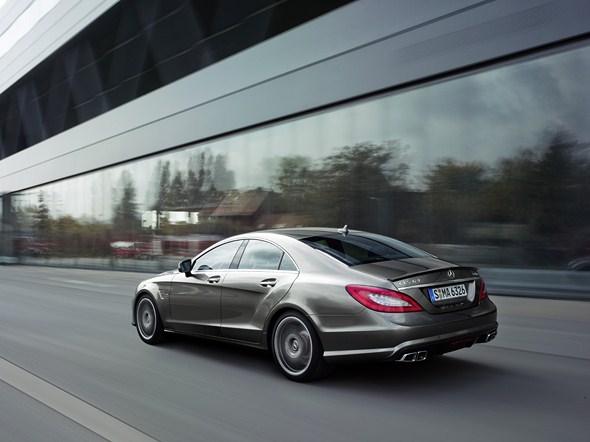
A large radiator at the car’s front end ensures defined cooling of the water circulating in the low-temperature circuit. This guarantees a high output and torque yield in all ambient temperatures and operating conditions. Extremely short charge air ducting makes for outstanding responsiveness.
The stainless steel pressure pipes for the fresh and charge air are produced by the hydroforming process, have a wall thickness of only 0.8 millimetres and are designed for particularly low pressure loss.
Aluminium crankcase with Silitec cylinder liners
The crankcase of the AMG 5.5-litre V8 biturbo engine is of diecast aluminium. The low (dry) engine weight of just 204 kilograms is the result of uncom-promising lightweight construction methods, and leads to the car’s very balanced weight distribution. The bearing cover for the main crankshaft bearings is of grey cast iron, and is bolted to the crankcase for high rigidity.
Cast-in Silitec cylinder liners ensure that the eight pistons operate with low friction. Drilled ventilation holes in the crankcase lead to a higher output and fuel savings under partial load: above the bearing blocks there are longitudinally drilled holes which connect the crankcase cavities arranged in series.
Normally the upward and downward movement of the pistons causes air to be forced into and extracted from the sump, which leads to increased internal friction losses and therefore a reduction in output. The ventilation holes prevent this by ensuring effective pressure compensation between the cavities.
The forged crankshaft of high-grade 38MnS6BY steel alloy rotates in five main bearings, has eight counterweights and has been optimised with respect to torsional rigidity, inertia, low rotating masses and a long operating life.
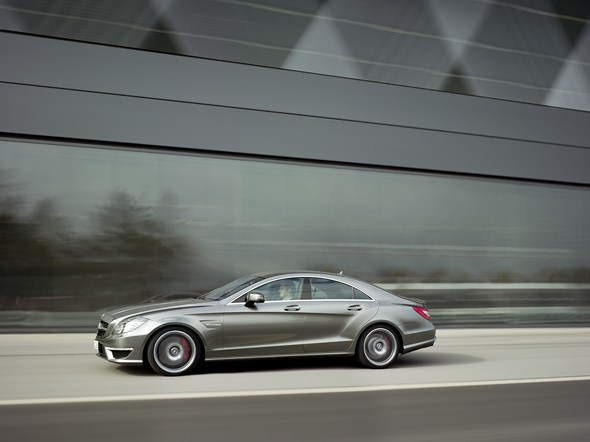
A two-mass viscous damper mounted at the front reliably eliminates vibrations. Each connecting rod journal on the crankshaft carries two forged, cracked connecting rods. In the interests of low mechanical friction and high wear resistance, the lightweight pistons have a metallic contact surface. Pressure-controlled oil-spray nozzles in the crankcase ensure that the highly stressed piston crowns are efficiently cooled.
Four-valve technology with variable camshaft adjustment
Perfect charging of the combustion chambers is ensured by large intake and exhaust valves, of which there are four per cylinder. The exhaust valves, which are subject to high thermal loads, are hollow and sodium-filled.
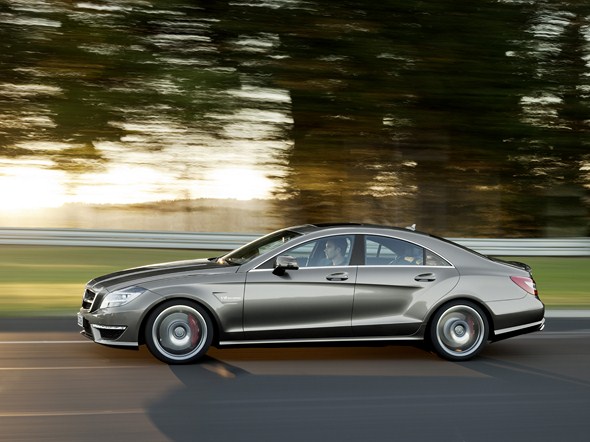
Four overhead camshafts operate the 32 valves via low-maintenance, low-friction cam followers. The infinitely variable camshaft adjustment within a range of 40 degrees on the intake and exhaust sides depends on the engine load and engine speed, leading to outstanding output and torque values.
This also results in consistent idling at a low speed. Depending on the engine speed, valve overlap can be varied for the best possible fuel/air supply to the combustion chambers and efficient removal of the exhaust gases. The variable camshaft adjustment is carried out electromagnetically via four pivoting actuators, and is controlled by the engine control unit.
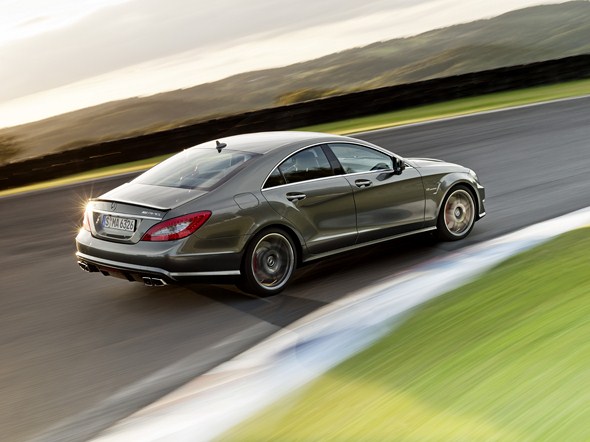
The camshafts are driven by three high-performance silent chains, which have considerable advantages in terms of noise comfort compared with cylinder roller chains.
Efficient oil supply and water cooling
Efficient oil delivery under all load and operating conditions is ensured by an oil pump with an electrically controlled compression stage. The oil pressure can be varied between two and four bar, which has advantages in terms of friction and fuel consumption.
An extraction stage integrated into the oil pump for the two turbochargers prevents oil from being entrained into the charge air and exhaust gases, thereby helping to reduce emissions even further. Both the sump and the extraction point have been optimised for maximum lateral acceleration and efficient lubrication. The oil capacity is 10.5 litres.
The combined water/oil cooling system is a particularly clever solution: after a cold start, initially the engine oil is only cooled via the oil/water heat exchanger. If the cooling performance of the very compact cooler is insufficient, the flow is additionally directed through the external engine oil/air cooler by an oil thermostat.
The advantage of this system is that the engine oil warms up more rapidly, as the engine coolant warms up faster and the oil is later cooled by the coolant. A selectable water thermostat ensures rapid warming of the coolant when starting the engine and driving off.
The engine coolant is cooled using the particularly effective crossflow principle. There is a transverse flow of coolant through both the crankcase and the cylinder heads. Additional cooling slots in the cylinder head ensure more efficient cooling of the combustion chambers, which has advantages during combustion: it enables earlier ignition timings to be chosen without incurring the risk of knocking.
Highly efficient engine electronics for every function
All the engine functions are executed and controlled by a particularly efficient Bosch MED 17.7.3. control unit. This state-of-the-art engine computer not only controls the direct petrol injection, charge pressure, camshaft adjustment and variable oil supply, but also communicates with all of the vehicle’s other onboard control units, such as those of the AMG SPEEDSHIFT MCT 7-speed sports transmission.
The microprocessor has more than 30,000 different parameters and functions stored in its memory, and is able to perform up to 260 million individual operations per second. To reduce the load on the engine control unit, the eight individual ignition coils have an integral electronic module – an ignition amplifier – at each cylinder. These ensure a strong ignition spark at all engine speeds and under all load conditions. The highly precise fuel distribution of the piezo-electric injectors is handled by eight high-voltage output stages.
Exhaust system with new catalytic converter housings
Low exhaust emissions, compliance with country-specific standards, a characteristic AMG engine sound and a weight-optimized design – the requirements for the exhaust system of the new AMG 5.5-litre V8 biturbo engine were manifold and complex. The CLS 63 AMG complies with all the current EU-5 emission standards, as well as meeting all the requirements of the US market (LEV-II standard, On-Board Diagnosis II and lambda sensor diagnosis).
The turbochargers are welded to the exhaust manifolds, while air gap-insulated manifolds with an inner shell measuring only 1.0 millimetre in thickness ensure a rapid catalytic converter response. For efficiency and to save space, this concept has a tandem catalytic converter housing on each side of the vehicle: adjacent to the firewall, two thin-walled ceramic substrates are grouped into each housing.
This solution makes the previous, additional underbody catalytic converters unnecessary. The two ceramic substrates differ to ensure rapid and efficient emissions control: the front one is coated with palladium, while the rear one has a bimetal coating of palladium and rhodium. One lambda sensor per row of cylinders is located in front of each catalytic converter housing, and there is a lambda diagnostic sensor between each of the two thin-walled substrates.
The on-demand lambda control guarantees optimum composition of the fuel/air mixture in all operating conditions, to avoid damaging the catalytic converters. This also benefits the fuel consumption under full load, as the mixture can be leaner than in engines without this control system.
Lightweight AMG sports exhaust system for a characteristic sound signature
The twin-pipe AMG sports exhaust system has a pipe cross-section of 70 milli-metres from the manifolds to the rear silencers. Thanks to a particularly intelligent lightweight design, it has been possible to save 4.3 kg of weight compared with the previous model. The AMG experts achieved this by reducing the wall thickness of all of the exhaust pipes as well as the centre and rear silencers to 1.2 millimetres.
When designing the sound, the aim was to create a perfect synthesis of perceived dynamism and the comfort on long journeys that is the hallmark of a Mercedes. The goal of the developers was to achieve an emotional experience when accelerating and double-declutching, but unobtrusiveness at constant speeds.
Unpleasant frequencies or droning noises were effectively eliminated during a series of painstaking tests. The sports exhaust system emits a sonorous eight-cylinder sound that is typical of AMG, while the striking chrome twin tailpipes feature a new design.
Engine production – tradition of hand-built excellence
Like all other AMG engines, the new eight-cylinder biturbo is assembled by hand in the AMG engine shop taken into commission in 2002. Highly-qualified technicians assemble the M157 according to the “one man, one engine” philosophy, maintaining the very strictest quality standards. This painstaking care is attested to by the signature on the characteristic AMG engine plate.
Long tradition of powerful AMG V8 engines
Powerful eight-cylinder engines are an inseparable part of AMG’s corporate history. Established in 1967, the company immediately caused a stir with the 300 SEL 6.8 AMG which succeeded in taking second place at the 24-hour races at Spa-Francorchamps (Belgium) in 1971.
The AMG racing saloon was technically based on the Mercedes-Benz 300 SEL 6.3. With an engine output of 184 kW (250 hp) at 4000 rpm and a top speed of 220 km/h, this luxury V8 saloon was Germany’s fastest regular production car at the time. Classic tuning as well as an enlarged displacement from 6330 to 6835 cc resulted in an increase in output to 315 kW (428 hp) at 5500 rpm and in torque from 500 to 608 Nm.
A further milestone in the AMG engine story was the M117, the first eight-cylinder unit with four-valve technology. With a displacement of 5.6 litres, 265 kW (360 hp) and 510 Nm of torque, this V8 accelerated the Mercedes-Benz 300 CE 5.6 AMG to a top speed of 303 km/h in 1987. This made the coupé the fastest German car in series production, and American fans reverently christened it “The Hammer”.
Another important engine in the history of AMG was the supercharged AMG 5.5‑litre V8 introduced in 2001: the M113 K developed an output of up to 428 kW (582 hp) and torque of 800 Nm. The supercharged AMG 5.5-litre V8 in the SLR McLaren of 2003 was even more powerful – the M155 developed up to 478 kW (650 hp) and 820 Nm.
2005 saw the debut of the AMG 6.3-litre V8 engine; depending on the model, the naturally aspirated, high-revving M156 developed up to 386 kW (525 hp) and 630 Nm. Exclusively reserved for the SLS AMG, the likewise 6.3-litre M159 has a maximum output of 420 kW (571 hp) and maximum torque of 650 Nm.
Numerous victories in the “International Engine of the Year Awards”
The supercharged AMG 5.5-litre V8, the AMG 6.3-litre V8 and the AMG 6.0-litre V12 biturbo were all able to win the Best Performance Engine category in the International Engine of the Year Awards. The AMG 6.3-litre V8 also won in 2009 and 2010 in the “Above 4 litres” class.
Power transmission
Maximum driving pleasure, reduced consumption
RACE START, double-declutching function, seven gears, four transmission modes and stop/start function: the power transmission of the new CLS 63 AMG combines extreme emotional appeal, maximum driving pleasure and optimum economy. The AMG SPEEDSHIFT MCT 7-speed sports transmission excites with a combination of unique options which no other automotive manufacturer is able to offer in this format.
The AMG SPEEDSHIFT MCT 7-speed sports transmission is exclusive to Mercedes-AMG and combines the sporty, direct and agile responsiveness of a manual transmission with the maximum comfort of an automatic transmission. MCT stands for Multi-Clutch Technology and indicates that only clutch elements are employed to perform gearshifts.
A compact wet start-up clutch, which runs in an oil bath, replaces the conventional torque converter. Thanks to its low rotational inertia, the transmission responds instantaneously and dynamically without the losses typical of a torque converter transmission – thereby helping to save fuel.
The AMG sports transmission also impresses with its low weight of just 80 kilograms, which has been made possible through the use of lightweight magnesium for the transmission housing. Vibrations are effectively eliminated by a new, two-stage torsion damper, with resulting benefits in perceived passenger comfort.
Stop/start function fitted as standard
As already featured in the S 63 AMG and CL 63 AMG, the Controlled Efficiency stop/start function is also fitted to the CLS 63 AMG as standard. This system is permanently active in the consumption-optimised “Controlled Efficiency” (C) driving mode.
Once the driver comes to a halt e.g. at a red traffic light or in a traffic jam, the engine is automatically switched off. Once the brake pedal is released or the accelerator is depressed, the engine is immediately restarted and the car is able to move off quickly.
Intelligent technology guarantees a comfortable and immediate starting procedure: a crankshaft sensor which recognises the direction of rotation registers the resting position of all eight pistons. For an automatic engine start, the cylinder with the most favourable piston position receives an injection of fuel into its combustion chamber. The precise piezo-electric injectors greatly assist this process, as they make particularly fast starts possible.
The engine management ensures that the engine is only switched off if certain preconditions are met. The starter battery must have sufficient charge, for example, and the engine must be at the necessary operating temperature for efficient emissions control.
The same applies to the interior temperature selected by the driver: if this has not yet been reached, the engine is not switched off when the car comes to a stop. The onboard network management system makes sure that active audio, telephone or video functions are not interrupted by the stop/start function.
A green “ECO” symbol shows the driver when the stop/start function is active. Should one of the above criteria be preventing activation of the system, this is shown in the central display by the message “Start/stop inactive” and a yellow “ECO” symbol. In the more performance-oriented driving modes “S” (Sport), “S+” (Sport plus) and “M” (Manual), the start/stop function is always deactivated.
Consumption-optimised Controlled Efficiency (“C”) drive mode
When adapting the MCT sports transmission to the AMG 5.5-litre V8 biturbo engine, the AMG engineers paid special attention to the new driving mode Controlled Efficiency (“C”). The emphasis was on delivering minimum engine speed in the highest possible gears in all driving situations.
When moving off in “C”, the transmission always selects second gear and shifts decidedly early to the next higher gears if the driving style permits. At 60 km/h for instance, sixth gear will already be engaged – not only improving fuel consumption but also noise levels.
Thanks to its powerful, readily available torque even at low engine speeds, the AMG V8 biturbo unit is absolutely ideal for this style of driving. Controlled Efficiency also means convenient gearshifts and a “soft” accelerator response set-up for outstandingly smooth power transfer. The use of a new low-friction oil as well as the implementation of further detailed measures in the AMG SPEEDSHIFT MCT 7-speed sports transmission enhance the efficiency and ensure an additional reduction in consumption.
The eight-cylinder biturbo engine also features a generator management system: whenever the engine is on the overrun or when braking, kinetic energy is used to charge the battery rather than being wasted as heat in the usual way. In all other operating modes a combination of onboard network and generator management enables the generator to be kept at a low voltage. This reduces the load on the engine and makes for fuel savings of around 0.15 litres per 100 kilometres according to the NEDC standard, and up to 0.2 litre per 100 km in city traffic
with its frequent overrun and braking phases.
Drive modes “S”, “S+” and “M” for even more driving pleasure and dynamism
In addition to Controlled Efficiency (“C”), three transmission modes are available to meet the demands of drivers looking for a more dynamic ride: in “S” (Sport) mode, the engine and transmission take on a much more agile character.
Accelerator pedal movements trigger a more direct traction response, making the downshifts more spontaneous. The engine speed is allowed to reach a higher level in each gear, while the gearshifts in “S” are around 25 percent faster than in “C”. Turning the rotary switch in the AMG DRIVE UNIT a notch further to the right activates “S+” mode. Sport plus shifts the gears another 25 percent faster than in “S”.
The same applies to the manual shift mode “M”. In “S+” and “M” modes, gearshifts at full throttle take just 100 milliseconds.
The engine management system partially suppresses cylinders in “S”, “S+” and “M” modes: precisely interrupting ignition and injection under full load for brief periods leads to even faster gearshifts than before. The highly emotional vocals are an appealing side effect of this lightning-fast process.
Ultra-fast, spontaneous multiple downshifts are another forte of the AMG SPEEDSHIFT MCT 7-speed sports transmission. For instance, kickdown allows gearshifts straight from seventh down to fourth gear, or from fifth to second.
In the “S”, “S+” and “M” driving modes the automatic double-declutching function is active. Every manual or automatic downshift is accompanied by precisely metered double-declutching – with increasing intensity from “S” through “S+” to “M”.
And this not only adds to the driver’s emotional experience: the load-free downshift minimises load-change reactions, which pays particular dividends when braking into bends – and also enhances safety in the wet or on ice.
No automatic downshifts in manual “M” mode
In manual “M” mode the driver also benefits from the high torque of the V8 biturbo engine, as there is no automatic downshift under full load and kickdown; the transmission remains steadfastly in the selected gear. Moreover, the 7-speed sports transmission does not perform an automatic upshift in manual mode when the rev limit is reached. In “M” mode the AMG instrument cluster displays the current gear and alerts the driver to the need for an upshift just before the needle reaches the red zone.
This means that a particularly sporty driver can use the superior performance potential to its fullest extent. When approaching the lower rev limit, e.g. when braking the vehicle, there is an automatic downshift to the next lower gear.
The powerful electronic transmission control unit with integrated 80 MHz processor controls spontaneous downshifts – for example if the driver suddenly needs power for dynamic acceleration.
AMG DRIVE UNIT with RACE START function
The AMG DRIVE UNIT is the central control unit for the AMG SPEEDSHIFT MCT 7-speed sports transmission and all driving dynamics functions. On the left next to the selector lever is the electronic rotary switch to select the four drive modes including activation of the RACE START function. Underneath are three buttons for additional functions: the first controls the 3-stage ESP®, the second the AMG RIDE CONTROL sports suspension.
The third, bearing AMG lettering, is used to store the personal set-up. Briefly pressing the AMG button brings up the configuration options, whilst holding down the button allows you to program the required set-ups – this is confirmed by an audible signal. The current settings may be viewed in the AMG instrument cluster by pressing the AMG button at any time.
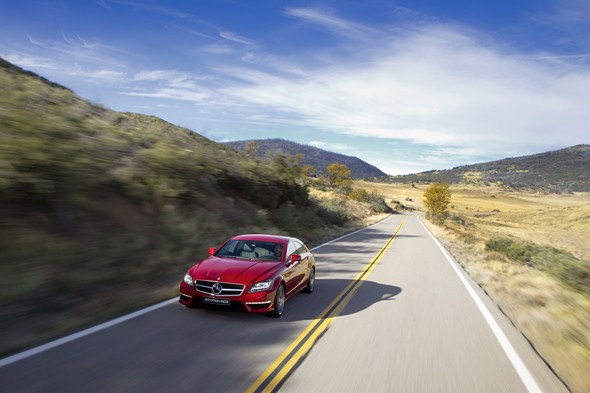
The RACE START function delivers maximum dynamism: while the vehicle is at a standstill, the driver can activate the ESP® sports function and press the brake pedal with their left foot. Having preselected the RACE START program using the rotary switch, a confirmation message comes up on the AMG central display. The driver then simply needs to confirm the RACE START function by pulling the “Up” shift paddle once, fully depressing the accelerator and taking his foot off the brake.
The optimum start-up engine speed is set fully automatically and the CLS 63 AMG accelerates away with flawless traction – all the way up to top speed, if so required. The driver does not need to shift gear manually; the AMG transmission changes gear with lightning-fast shift times.
Chassis and braking system
Agile, dynamic, exclusive
The CLS 63 AMG also occupies an exceptional position in the areas of suspension and the braking system. The exclusive combination of AMG RIDE CONTROL sports suspension, electromechanical AMG sports parameter steering and AMG high-performance braking system guarantees a high level of driving dynamics, awe-inspiring agility and at the same time renowned Mercedes comfort on long journeys.
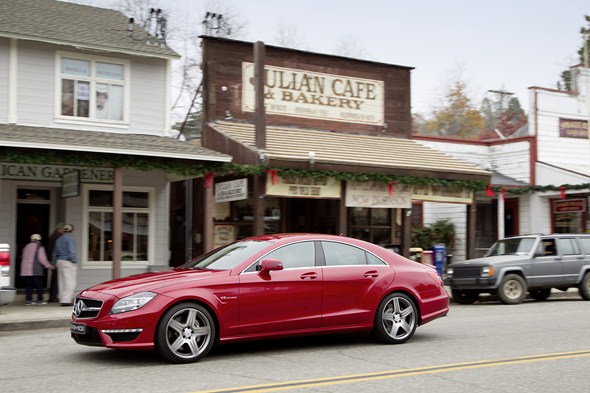
For the CLS 63 AMG, the AMG engineers developed a new AMG RIDE CONTROL sports suspension which is characterised by a high degree of variability. A steel suspension is used at the front, and an all-air suspension system at the rear.
This solution guarantees a sensitive response from the front springs while the vehicle is kept at a constant height thanks to the automatic level control system – irrespective of the load. The top-of-the-line AMG model differs from the other CLS variants with its newly developed three-link front suspension with wider track – increased by 24 mm, to 1623 mm, compared with the CLS 500.
In conjunction with new hub carriers for more negative camber at the front, this provides much more grip when taking bends at high speed.
Another feature of the AMG RIDE CONTROL sports suspension is the electronically controlled damping system: the system varies the damping characteristics instantly according to the driving situation, road speed and load status, reducing the roll angle of the body.
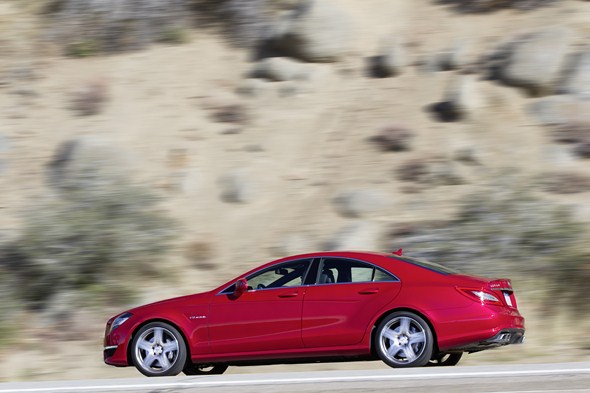
For the driver this means instant, continuously variable adjustment between the greatest possible agility and optimum ride comfort – depending on the driving style and route. The damping can also be individually adjusted by pressing the appropriate button in the AMG DRIVE UNIT. A push of a button is all it takes for the electronics to switch from “Comfort” to “Sport” or “Sport plus.” The selected mode is displayed in the AMG instrument cluster.
“Comfort” delivers a sensitive response with soft damping characteristics, while the shock absorber response is an average 40 percent firmer in “Sport”. “Sport plus” is ideal for challenging laps on a racetrack: in addition to the higher damping force, this mode comes with specific control algorithms that have been tailor-made for a decidedly sporty driving style on level road surfaces.
The driving dynamics of the CLS 63 AMG can be upgraded even further ex factory: exclusive optional extras available from the AMG Performance Studio include a stiffer performance suspension, lightweight forged AMG light-alloy wheels and also a rear axle locking differential with a 40 percent locking action.
Eleven sensors for electronic damper control
The electronic damper control utilises four sensors to permanently monitor the drive and brake torque along with steering angle and lateral acceleration. Four position sensors are also used to determine the ride height and to ascertain the direction of motion.
Three acceleration sensors help identify the absolute body roll. Powerful control electronics that interact constantly with the engine and transmission control units instantly adjust the forces at the four shock absorbers.
New axle components and more direct steering
The high-grade axle components, made for the most part from aluminium, are further evidence of the painstakingly redesigned AMG RIDE CONTROL sports suspension. New steering knuckles, wishbones, torque strut bearings and head bearings at the front provide extra stability and improved road contact.
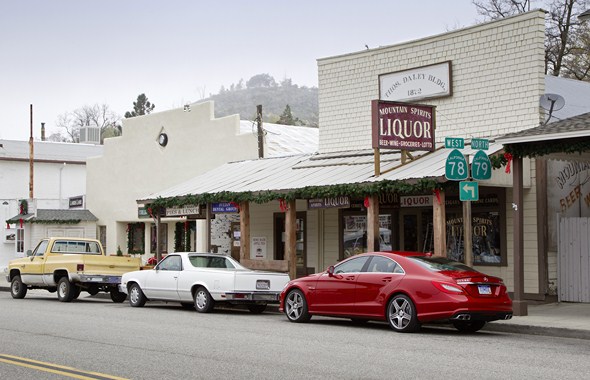
A weight-optimised, thicker tubular stabiliser reduces body roll on fast S-shaped bends. The rear suspension has also been substantially reworked in the interests of enhanced handling stability: new track rods, push-pull rods and far more rigid mountings for the subframe – on which the rear axle is mounted – translate into enhanced dynamics when cornering.
The AMG-specific kinematics and the new elastokinematics on both axles also noticeably increase precision during cornering – a solution that has already proven itself on the C 63 AMG.
New, more direct electromechanical steering ratio
This is complemented by the newly developed electromechanical AMG sports parameter steering: with a steering ratio (14:1) which is 22 percent more direct than that of other CLS models, and in conjunction with the variable power assistance which adapts according to the suspension mode, it provides for decidedly agile handling when cornering.
In addition, the electromechanical AMG sports parameter steering also makes an important contribution to efficiency, since the steering assist function only requires power when the driver actually steers. Compared with the previous model with regular hydraulic power steering, this enables savings of up to 0.3 litre/7 g CO2 per 100 km (NEDC combined) to be achieved.
In the new steering system the steering gear and the supporting servo-motor form a single compact unit and are mounted as previously on an extremely rigid and low-weight integral support frame, made of high-strength steel, which is positioned in front of the wheel’s centre line.
The high-performance control unit processes a variety of parameters captured by the sensors – including vehicle speed, steering angle, steering angle speed, lateral acceleration and also understeer/oversteer characteristics – and in a split second calculates the forces which the driver needs to input into the steering in different driving situations – from parking to high-speed motorway driving. Active damping enhances the feeling of safety when driving straight ahead at high speed.
AMG-specific solutions for enhanced steering precision and driving dynamics
An AMG-specific solution has been implemented in the form of the fixed, programmed power assistance characteristics. In suspension mode “C”, the AMG sports parameter steering has a comfortable feel, providing a higher level of steering assistance. In “S+” mode, on the other hand, the driver will discern reduced steering assistance – which tends to result in a better road feel.
This in turn results in enhanced response and steering precision. Another AMG exclusive is the interaction between the new steering and the 3-stage ESP®: the driver will feel if the vehicle starts to understeer thanks to a defined superposition of a steering moment earlier than with a regular power steering system. In “ESP SPORT” and “ESP OFF”, the special control algorithm helps the driver to achieve a cleaner side-slip angle.
In addition to more precise steering and a more comfortable feel at the wheel, the new electric power steering offers a range of additional advantages. Power assistance remains available when the engine is stationary, for example – whereby an algorithm ensures that the combustion engine is not prompted to start up in ECO start/stop mode when the driver is merely moving the steering wheel while the vehicle is at a standstill.
The new steering system has also enabled implementation of the “Active Park Assist” automatic parking function and relieves the strain on the driver on road surfaces which slope away towards the kerb.
The new steering system also assists with braking on a surface with vastly varying grip (split friction surface). Sensors recognise the impending yaw if the vehicle starts to turn in towards the side of the lane with more grip. Through the superposition of a steering moment the driver receives an impulse to countersteer.
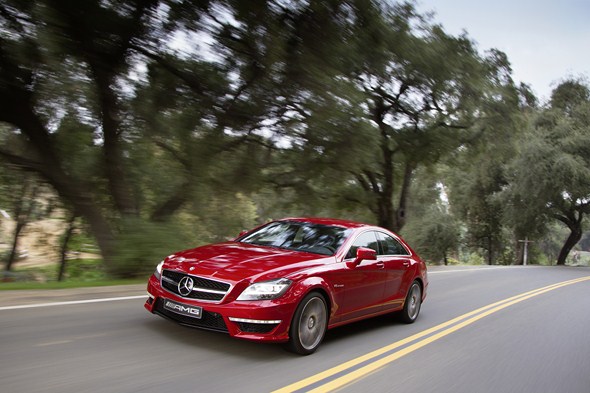
If s/he acts on this signal, the steering moment is withdrawn. Deploying the Steering Assist on split friction surfaces can help to improve both the directional stability and also shorten the braking time.
3-stage ESP® with Sport function
The 3-stage ESP® is also consistently tailored to the superb dynamic qualities of the CLS 63 AMG: the Electronic Stability Program supports three individual control strategies at the push of a button: the ESP® button in the AMG DRIVE UNIT allows the driver to choose between “ESP ON”, “ESP SPORT” and “ESP OFF” – with the currently active mode shown in the display of the AMG instrument cluster.
In “ESP ON”, the onset of handling instability leads to braking intervention at one or more of the wheels, accompanied by a reduction in engine torque.
Briefly pressing the ESP® button activates “ESP SPORT”. In this mode the braking intervention to counter oversteer or understeer, as well as the accompanying reduction in engine torque, allows a higher dynamic threshold and, for instance, corresponding drift angles – thereby significantly enhancing driving enjoyment.
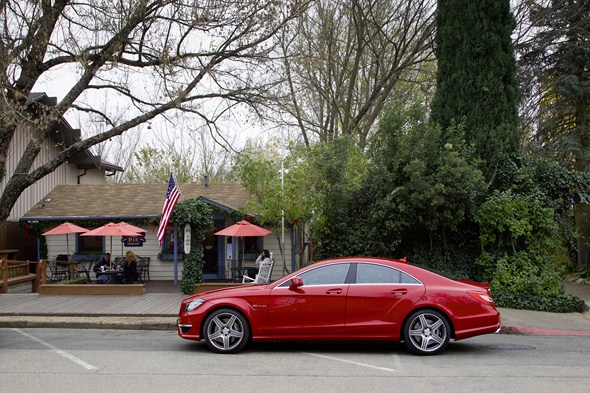
Operating the brake pedal restores all the normal ESP® functions. Prolonged pressure on the ESP® button activates “ESP OFF”. In the interests of handling dynamics, there is no further reduction in engine torque – with the result that driving enjoyment is increased even further. “ESP OFF” should only be used by experienced drivers on dedicated racetracks. In this mode too, operating the brake pedal restores all the normal functions of ESP®.
The system’s traction logic is active in all three ESP® modes. If one of the drive wheels starts to spin, specific brake pressure is applied to virtually create the effect of a mechanical differential lock. This means that the engine power is transferred to the road even more effectively.
New ceramic composite high-performance braking system available as an option
As you would expect from an AMG high-performance car, the new CLS 63 AMG also comes with an ultra-powerful braking system. Internally ventilated and perforated brake discs with a generous 360-millimetre diameter are fitted front and rear.
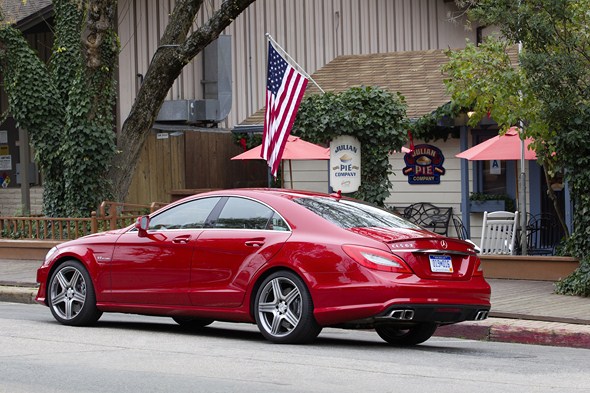
Because of the special stresses they face, the front discs feature composite technology that has been tried and tested in motor racing to help offset the temperature peaks more effectively. Grey-painted brake callipers with white AMG lettering and six-piston (front) and four-piston technology (rear) provide responsive, fade-resistant deceleration and extremely short stopping distances.
AMG ceramic composite high-performance brakes are available as an option and are instantly recognisable thanks to the “AMG Carbon Ceramic” logo on the brake callipers. Thanks to the special materials and production technology used to manufacture the discs from carbon-fibre-reinforced ceramic in a vacuum at 1700 degrees Celsius, the ceramic discs are much harder.
This not only increases the service life many times over compared with a grey cast iron disc, but also their resistance to extreme loads and heat. The result is extremely short stopping distances, an exact pressure point and much higher fade resistance even under extreme operating conditions.
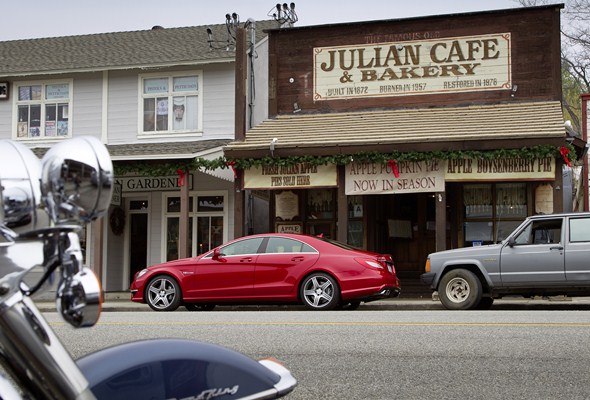
The larger ceramic discs – front: 402 x 39 millimetres; rear: 360 x 32 millimetres – also feature a composite design and
are connected with a floating radial mount to an aluminium bowl.
Compared with the conventional composite brake discs, the ceramic brake discs are around 40 percent lighter. The further reduction in unsprung masses not only boosts driving dynamics and agility but also improves steering response as well as ride comfort and contact characteristics. Six-piston fixed callipers are fitted at the front with a brake lining surface of 2 x 154 cm2; four-piston fixed callipers with a brake lining surface of 2 x 73 cm2 are used at the rear.
Overview of brake data:
| Composite braking system | Composite ceramic braking system | |
| Front axle: | ||
| Brake calliperBrake disc
Diameter Thickness Weight* | 6-piston aluminium fixed calliperComposite technology, internally ventilated, perforated 360 mm 36 mm 13.6 kg | 6-piston aluminium fixed calliperCeramic composite technology, internally ventilated, perforated402 mm 39 mm 7.9 kg |
| Rear axle: | ||
| Brake calliperBrake disc Diameter Thickness Weight* | 4-piston fixed calliperSolid, internally ventilated, perforated360 mm 26 mm 11.1 kg | 4-piston fixed calliperCeramic, solid, internally ventilated, perforated360 mm 32 mm 6.2 kg |
* weight of the brake disc
Numerous functions of the high-performance braking system enhance comfort and safety. Take the practical HOLD function: if the CLS 63 AMG has come to a stop, the driver simply needs to press the brake pedal a little bit firmer. The vehicle is now held by the brake – even if the driver takes their foot off the brake pedal.
This prevents the vehicle from unintentionally rolling forward in stop-and-go traffic or inadvertently rolling back on an uphill slope. The HOLD function is automatically disengaged once the vehicle is driven forward. Another useful feature comes in the shape of the hill-start assist.
If the sensor technology detects that the driver has stopped on an incline, the brake pressure is automatically maintained constant for a short period. This means the CLS will not roll back and the driver has sufficient time to switch from the brake to the accelerator pedal without having to use the parking brake.
If the driver suddenly switches from the accelerator to the brake pedal prior to emergency braking, the braking system increases the pressure in the brake lines and applies the pads to the brake discs, so that they can grip instantly with full force when the brake pedal is pressed.
The system supports the standard-fit Brake Assist by means of this ‘priming’.
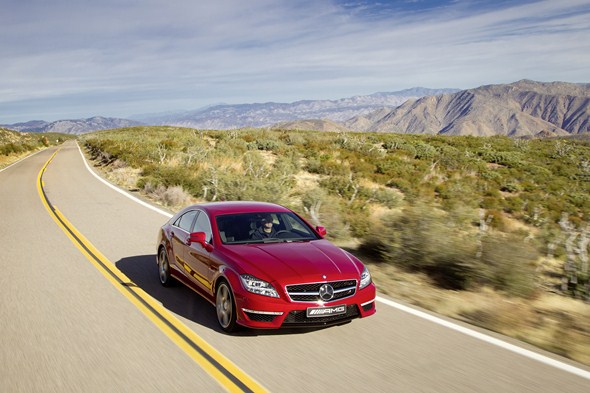
Further standard features include the brake-drying function, which uses brief braking impulses to ensure the film of water on the brake discs is removed in the wet, thus considerably improving the responsiveness of the brakes.
Weight-optimised “Flow Forming” AMG light-alloy wheels
The newly developed AMG light-alloy wheels make a significant contribution to the dynamic handling of the CLS 63 AMG. As on the SLS AMG, they are produced by the new “flow forming” process. During this production process, hot forming in the area of the rim base makes for a denser material structure, thereby improving long-term durability.
This also means that lower wall thicknesses
can be achieved. The weight saving of up to 0.8 kg per wheel compared to conventional light-alloy wheels reduces the unsprung masses, further improving the handling dynamics and suspension comfort.
The Coupé is fitted as standard with titanium grey-painted wheels featuring a high-sheen finish and new triple-spoke design. The 9.0 x 19 format front wheels are fitted with 255/35 R 19-size tyres, while the 10 x 19 format rear wheels come with 285/30 R 19-size tyres. Available as an optional extra from the AMG Performance Studio are AMG light-alloy forged wheels in a 5-twin-spoke design and painted in titanium grey with a polished finish. They come with 255/35 R 19 (front) and 285/30 R 19 (rear) wide-base tyres.
Active safety
New assistance for drivers
Avoiding accidents and reducing the consequences of accidents: this is the comprehensive approach adopted by Mercedes-Benz in its safety research and referred to collectively by the company as “Real Life Safety”.
As part of this, a variety of systems designed to reduce the burden on the driver even further will be making their debut in the new CLS. These include Active Blind Spot Assist and Active Lane Keeping Assist as well as LED High Performance headlamps offering various light functions. The new features represent a further improvement of so-called “driver-fitness safety” by the company’s engineers.
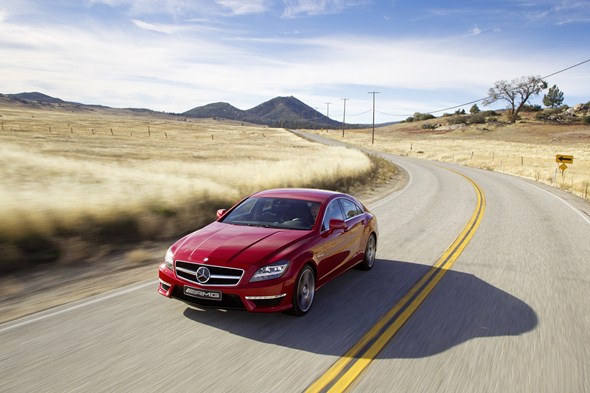
In addition to ride and seating comfort and also quiet running, a significant role is also played by the headlamp and windscreen wiper systems, for example, as well as the easy, safe operation of the vehicle. On top of this there are also the PRE-SAFE® systems which can warn, support and protect the driver when a real risk of an accident has been detected.
LED High Performance headlamps with complete light functionality
The new CLS 63 AMG is the first car in the world to feature LED High Performance headlamps as standard, which combine the exciting daylight colour impression of LED technology with the performance, functionality and energy efficiency of today’s bi-xenon light generation.
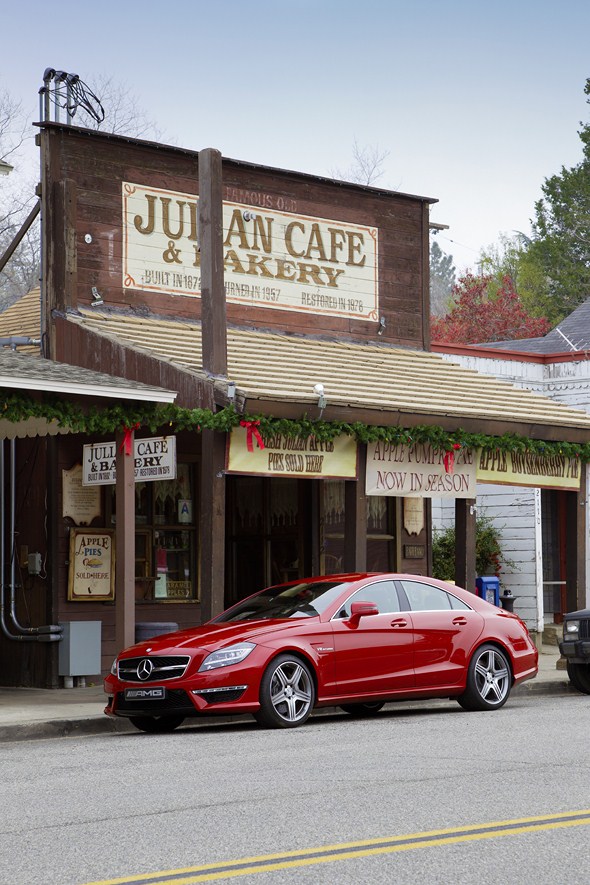
The new light system features the Intelligent Light System which has already been tried and tested in Mercedes-Benz models with bi-xenon headlamps. Its five light functions – country mode, motorway mode, enhanced fog lamps, active light function and cornering light function – have been specifically designed for typical driving or weather conditions.
In contrast to the first vehicles equipped with LED headlamps, no compromises are now necessary with respect to the functionality and performance of the lighting technology. There are further arguments for the new, LED-based lighting technology: the average operating life of an LED is around 10,000 hours, around five times longer than that of a xenon light; moreover, LED headlamps most closely approximate to the colour of daylight.
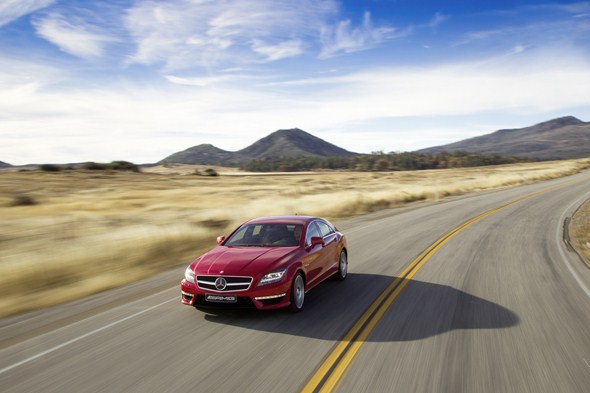
This means that LED light is in keeping with the normal human perception patterns. Studies have shown that the closer the colour of artificial light comes to daylight, the less the strain on the eyes. With a colour temperature of 5500 kelvin, LED light is closer to daylight (6500 K) than xenon light (4200 K). The driver’s experience of this effect is that colour impressions at nighttime seem close to daylight colours and s/he has the feeling that there is greater brightness on the road.
The light specialists at Mercedes-Benz have also been able to combine LED technology with the innovative Adaptive Highbeam Assist for the first time, leading to a completely new level of safety at night.
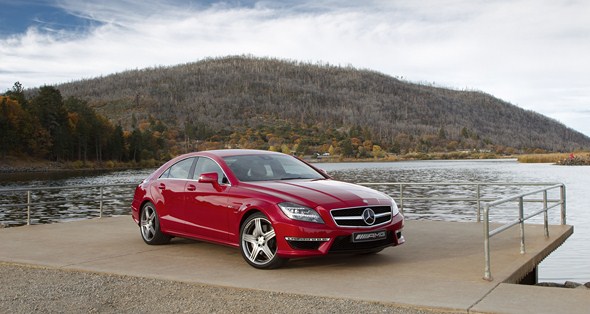
The basic principle behind Adaptive Highbeam Assist is as follows: if the system detects an oncoming vehicle or a vehicle in front with its lights on, the system dims the headlamps and continually adjusts the headlamp range in such a way that the cone-shaped beam of headlamp light does not reach these vehicles. There is, in addition, the Night View Assist Plus system as an option.
But good visibility is not only needed at night – and can also depend on a number of seemingly irrelevant factors. So that the CLS driver’s view when looking forward at an angle is not obscured – despite the angled coupé-like windscreen and A-pillars – the exterior mirrors are not mounted in the window triangle.
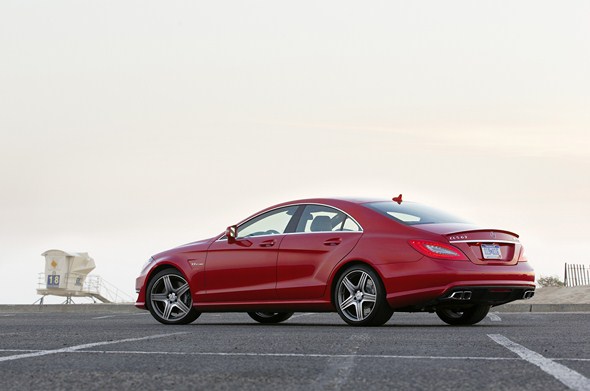
Instead they have been given a new position directly on the beltline. This improves all-round visibility, especially when turning into side streets, for example.
Active Blind Spot Assist and Active Lane Keeping Assist
Assistance systems are becoming increasingly important these days, providing support for drivers as they perform a complex activity. In the new CLS 63 AMG, for example, proven technologies like ABS, 3-stage ESP® and Brake Assist work alongside a dozen assistance systems to help prevent accidents and reduce their impact.
These range from drowsiness detection to automatic full brake application on recognising that there is an acute risk of a collision, and from Adaptive Highbeam Assist to traffic sign recognition.
One new feature is the Active Blind Spot Assist. It warns the driver when changing lanes if a risk of collision is detected due to another vehicle in the neighbouring lane being in the so-called blind spot of the exterior mirror. If the driver ignores the warning and nevertheless initiates the lane-changing manoeuvre, the Active Blind Spot Assist intervenes.
Thanks to course-correcting brake application, via ESP®, to the wheels on the opposite side of the vehicle, a yaw movement is created which counteracts the collision course.
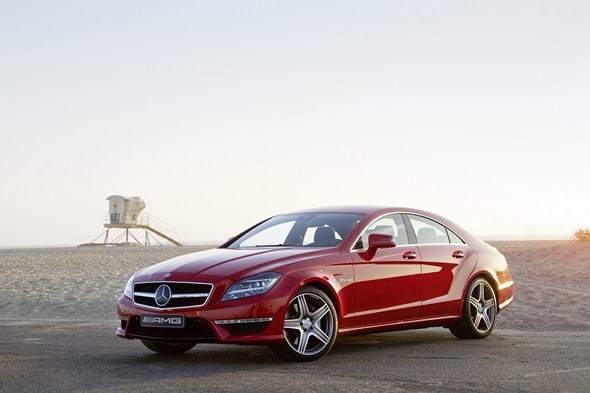
Active Lane Keeping Assist is now also linked to the ESP® for the first time. This system kicks into action if the Mercedes vehicle inadvertently drifts over a solid line to the right or left of a lane. In such a case, a warning sign in the instrument cluster and vibration of the steering wheel give the driver warning. If the driver does not heed the warning in the case of the solid line, Active Lane Keeping Assist can use the ESP® to brake the opposite wheels and thereby prevent the vehicle from crossing the solid line.
Premiere: Active Parking Assist including PARKTRONIC
Active Parking Assist will answer the prayers of many drivers in the chronically congested traffic areas of Europe: the CLS can not only detect parking spaces, but also help with the parking itself. This is made possible thanks to a combination of the new electromechanical Direct-Steer system and a series of ultrasonic sensors. This convenience system features the following functions:
- · Measurement of the length and depth of potential parking spaces at a vehicle speed of up to 36 km/h
- · Calculation of a suitable parking course based on the current position of
the vehicle- · Control of the steering in order to maintain this parking course.
Parking spaces are measured using two enhanced ultrasonic sensors integrated into the right and left sides of the front bumper. Depending on the speed and driving cycle, these sensors are used to measure parking spaces and also to support the PARKTRONIC functionality.
When driving at less than 30 km/h, a “P” symbol is displayed in the instrument cluster to inform the driver that the active parking space search function is enabled. If a parking space is found, an arrow appears next to the “P” symbol.
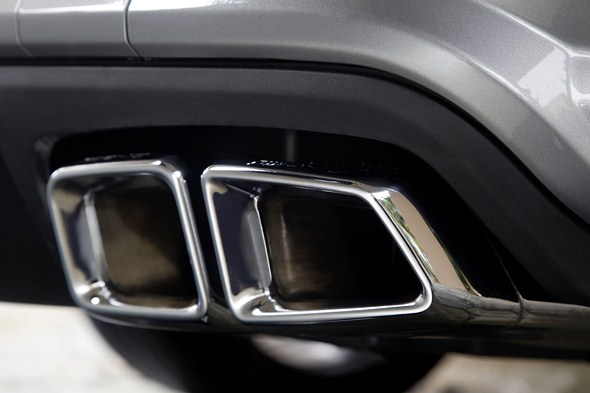
By default the arrow indicates parking spaces on the front-passenger side. If the turn indicator is set to the driver’s side, parking spaces on the driver’s side will be displayed. It is not necessary to switch on the parking space search function. The ultrasonic sensors only carry out a geometric assessment of the potential parking space, and do not assess whether this free space is actually a parking space. Responsibility during the parking process also remains with the driver. If the ultrasonic sensors detect a pavement then the vehicle is parked parallel to this.Automatic steering: this is how the parking process works
The Active Parking Assist parking process begins when the vehicle is in front of the parking space indicated by the arrow, facing the direction of travel, and the driver has engaged reverse gear and confirmed an appropriate warning dialogue with the system via the instrument cluster. The driver continues to control the accelerator and brake pedals whilst manoeuvring into the parking space.
The Active Parking Assist takes over lateral guidance by controlling the electric steering in accordance with the longitudinal dynamics specified by the driver and the parking course.
The maximum speed of this parking process is limited to 10 km/h. If the speed reaches 7 km/h, a warning appears in the instrument cluster – “Parking Assist only functions up to 10 km/h” – accompanied by a warning tone.
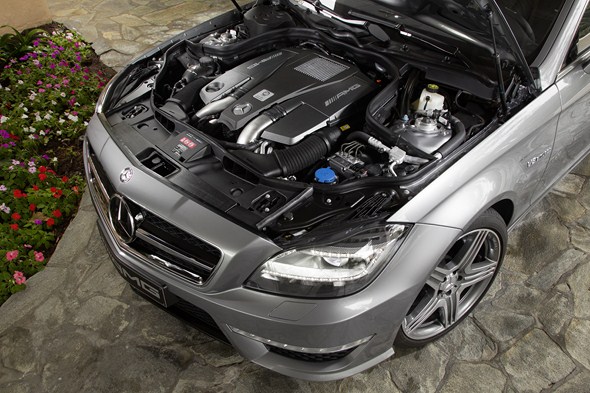
The familiar PARKTRONIC function can be used without any restrictions being imposed. The system switches off as soon as the driver intervenes in the automatic steering control process, switches off the system via the PTS (Parktronic Sensor) button,
both the driver’s seat belt buckle is released and the driver’s door opened, or a system error occurs.
The entire PARKTRONIC and Active Parking Assist system comprises the following components:
- · Control unit
- · Ten ultrasonic sensors, two of which have an extended range
- · PTS warning elements on the dashboard and in the roof lining at the rear
- · PTS button
A maximum of five manoeuvres are allowed (backwards-forwards-backwards-forwards-backwards). The wheels are then straightened out again. The final parking manoeuvre is notified in the instrument cluster with the message “Parking Assist completed”, accompanied by a confirmation tone.
ATTENTION ASSIST warns of drowsiness
Studies have shown that around a quarter of all serious motorway accidents are caused by drowsy drivers, making this factor an even bigger cause of accidents than drink-driving.
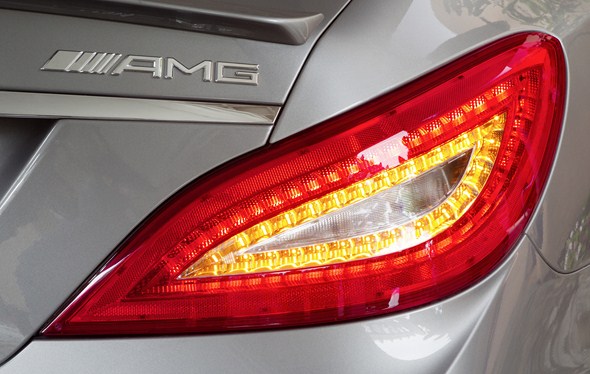
With ATTENTION ASSIST, fitted as standard in the new CLS, Mercedes-Benz is therefore making another important contribution towards helping to avoid accidents: it employs high-resolution sensors to observe driver behaviour and can recognise whether the driver is tired or not paying attention, based primarily on steering wheel movements.

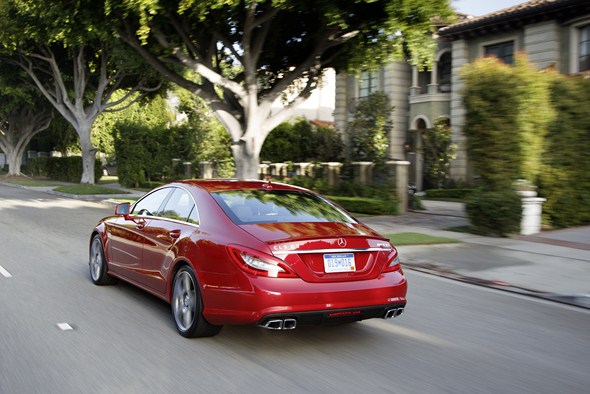
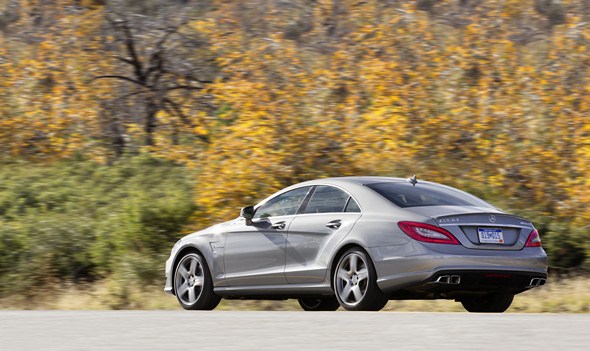
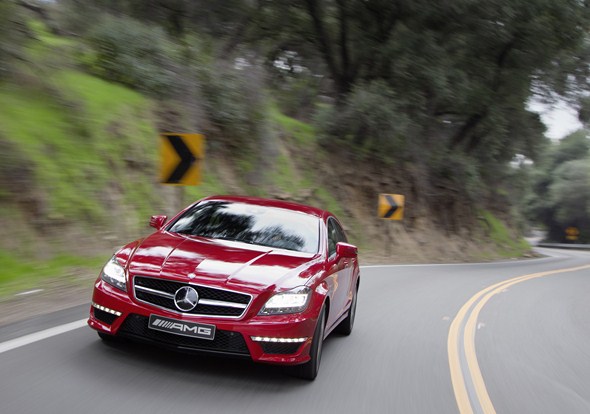
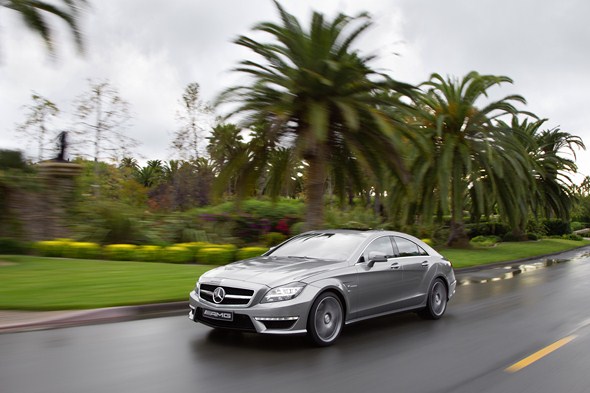
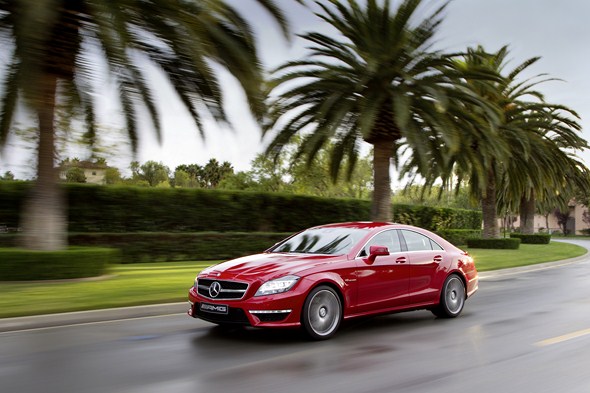
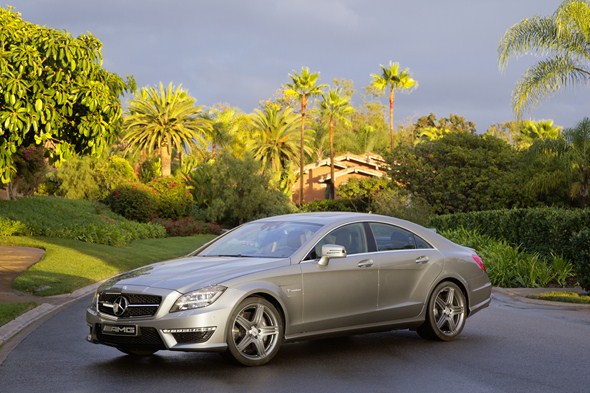
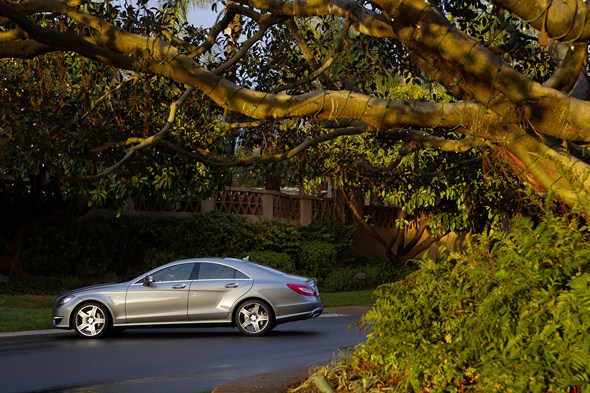
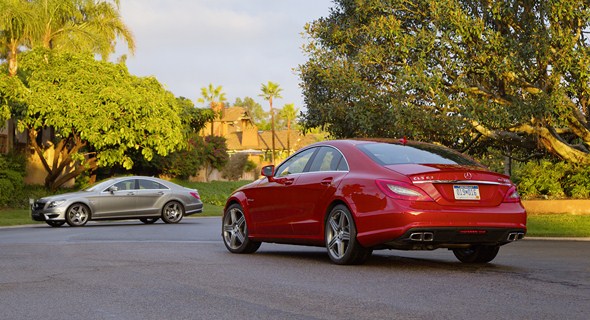
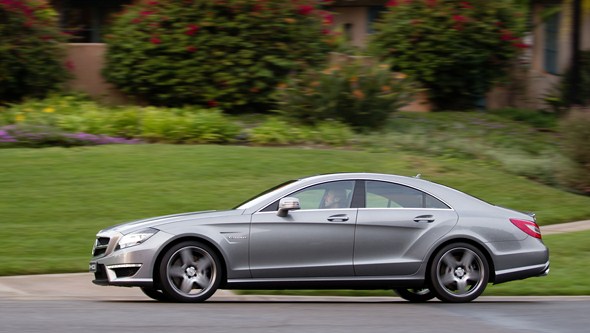
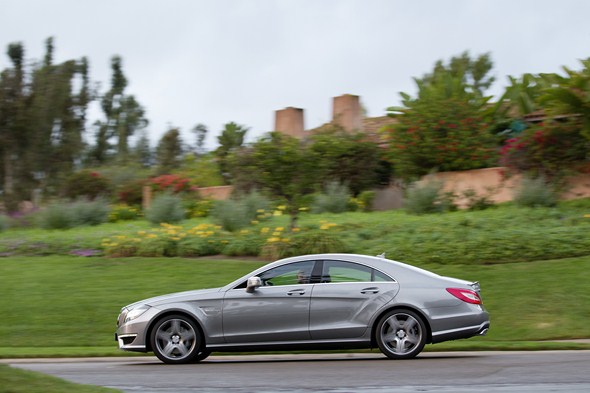

The ATTENTION ASSIST system developed by Mercedes-Benz measures more than 70 parameters which are analysed to detect fatigue. This continual monitoring is important in order to recognise the gradual transition from alertness to tiredness and give the driver plenty of warning. Based on a variety of data, ATTENTION ASSIST creates an individual driver profile during the first few minutes of each journey and compares this with sensor data and the driving situation as recognised by the vehicle’s electronic control unit. Alongside values such as the steering behaviour of the driver, the Mercedes-Benz system also measures driving conditions such as speed, longitudinal/lateral acceleration, indicator and pedal usage, as well as external factors such as the unevenness
of the roads, for example.
DISTRONIC PLUS: now with enhanced functions
The radar-based DISTRONIC PLUS proximity control supports the driver at speeds between zero and 200 km/h by automatically adjusting the distance to the vehicles in front. In doing so it is able to apply the brakes to bring the vehicle to a complete standstill and also accelerate it again. As a result, the system is also particularly convenient in stop-and-go traffic. If the system detects that the distance is being reduced too quickly, it warns the driver with both visual and audible signals.
With the introduction of the new generation of the CLS, the functionality of DISTRONIC PLUS has been enhanced even further. It now reacts earlier to vehicles which cut in, and the vehicle accelerates quicker when changing lanes itself and where the overtaking lane is clear.
Additional assistance: from the ADAPTIVE BRAKE to the PRE-SAFE® Brake
- · ADAPTIVE BRAKE: this Mercedes-Benz brake system offers assistance functions for greater safety and comfort, such as a HOLD function when waiting at traffic lights, and Hill-Start Assist which can help prevent rolling backwards when moving off on a slope.
- · Adaptive Highbeam Assist: when vehicles are detected ahead of or oncoming to the vehicle, this system automatically dips the beams and adjusts the range of the headlamps appropriate to the distance.
- · Brake Assist PLUS: this system is able to recognise an impending rear-end collision using radar sensors. It calculates the necessary degree of braking assistance and makes it available immediately when the driver presses the brake pedal.
- · Headlamp Assist: a sensor on the windscreen detects the lighting conditions. As a result, the headlamps can be turned on automatically when darkness falls.
- · Speed Limit Assist: a camera fitted behind the windscreen detects speed limit signs at the roadside and compares this data to information contained in the GPS system. The relevant speed limit is then displayed in the instrument cluster.
- · Night View Assist PLUS: the display in the dashboard shows a realistic grey-scale image from an infrared camera that monitors the road ahead of the vehicle. Any pedestrians detected are additionally highlighted in the display with so-called photo corners.
- · PARKTRONIC: ultrasonic sensors assist the driver when parking.
- PRE-SAFE® Brake: autonomous braking if acute danger of an accident is detected. At first the driver is given both an acoustic and an optical warning if the system identifies there is a danger of collision. If the driver does not react to this, the system brakes the vehicle autonomously. This occurs in two stages: around 1.6 seconds before the calculated impact point the system decelerates the car with around 40 percent (approx. four m/s²) of the maximum braking power, gives the driver an additional, haptic warning of the impending impact and as a precaution activates the reversible PRE-SAFE® occupant protection system. If the driver still fails to react, the PRE-SAFE® Brake activates the maximum braking power around 0.6 seconds before the now unavoidable collision – this emergency braking can greatly reduce the severity of the impact. The system therefore acts like an “electronic crumple zone”, offering the car occupants even greater protection. The PRE-SAFE® Brake is active at speeds of between 30 and 200 km/h when moving vehicles are detected in front of the car. The system also reacts if the car approaches a stationary queue of traffic, providing its speed is below 70 km/h.
Passive safety
Nine airbags as standard
With nine airbags fitted as standard, not to mention four seat-belt tensioners and belt-force limiters as well as NECK-PRO crash-responsive head restraints for the driver and front passenger, the new CLS offers an even more extensive package of safety equipment than its predecessor. New additions include pelvis bags in the front and adaptive belt force limiters
in the rear.
Drivers of Mercedes vehicles are safer on the road than drivers of other car brands. This is the result of a study by Mercedes-Benz accident research based
on official, anonymous data samples from the Federal Office of Statistics. Having looked at around 18,700 accidents resulting in personal injury during the period from 2003 to 2007, the study found that the risk of being seriously or fatally injured as the driver of a Mercedes is 9.6 percent lower than for vehicles of other brands. The result represents clear evidence of the contribution made by the passive safety systems of Mercedes-Benz to reducing the consequences of an accident.
The main prerequisites for this include a stable body structure as well as a whole host of sophisticated restraint systems. The airbags, which can deploy in a matter of milliseconds in the event of an accident, include two adaptive airbags for the driver and front passenger, a kneebag for the driver, two sidebags in the front-seat backrests and two large windowbags which extend from the A-pillar to the C‑pillar during a side impact. For the first time, pelvisbags are included as standard for front seat passengers, which in the event of a side collision can help to reduce loads in the pelvic area. Sidebags are also available for the rear as an optional extra, which means that the new CLS makes a total of eleven airbags available for occupant protection.
Three-point automatic safety belts with belt tensioners and belt force limiters are fitted as standard for the driver, front passenger and rear passengers. Mercedes-Benz is offering adaptive belt force limiters for the rear seats as an option. These adapt to the size of passengers automatically. The system detects whether the rear seat passenger is large or small as soon as the seat belt is put on, based on the length of the pulled-out seat belt, and can adapt its protective effect accordingly. The maximum belt force is activated immediately if the rear passenger is large in size, while in the case of smaller occupants the force
exerted by the belt is initially set to a lower level.
For the first time Mercedes-Benz is offering the CLS with ISOFIX, the international standard securing system for child seats. The mechanism is fitted as standard and comprises two retaining brackets in each rear seat position, in the gap between the back rest and seat cushion, as well as an additional third anchor point, the so-called top tether.
NECK-PRO is the name Mercedes-Benz has given to a crash-responsive head restraint whose development, like that of PRE-SAFE® and other Mercedes-Benz innovations, is based on analyses of real accidents. NECK-PRO is an effective means of reducing the risk of whiplash injuries during a rear-end collision. If
the sensor system detects a rear-end collision with a defined impact severity,
it releases pre-tensioned springs inside the head restraints, causing the head restraints to move forward by about 40 millimetres and upwards by 30 milli-metres within a matter of milliseconds. This means that the heads of the driver and front passenger can be supported at an early stage.
The PRE-SAFE® occupant protection system
In 2002 Mercedes-Benz became the first automotive brand to offer an anticipatory occupant protection system which can initiate measures to protect the occupants of the vehicle if there is an imminent risk of an accident: PRE-SAFE®. Mercedes-Benz’s intelligent approach takes its lead from nature: PRE-SAFE® activates protective measures for the car occupants as a precaution, just as living things react instinctively and search for cover when they are in danger. The aim is to prepare the occupants and vehicle for an imminent collision so that the seat belts and airbags are able to fulfil their protective function to the full during an impact. What’s more, the PRE-SAFE® protective measures are reversible: if the accident is averted, the advance tensioning of the seat belts is halted automatically and the occupants are able to reset the positions of the seats and the sliding sunroof.
The anticipatory occupant protection system is then ready for action again straightaway.
Early accident detection is possible because PRE-SAFE® is an intelligent synergy of active and passive safety. It is linked to Brake Assist and the Electronic Stability Program (ESP®), whose sensors detect potentially critical driving situations and send the relevant information to the electronic control units
within a matter of milliseconds.
The new CLS is able to offer even more preventive measures ahead of an imminent accident than ever before:
- · Whereas PRE-SAFE® previously responded to emergency or panic braking – in other words when the driver hit the brake pedal reflexively – the system in the new CLS can also be activated if the optional DISTRONIC PLUS has detected an impending collision with the aid of short and long-range sensors, and a certain level of delay in braking has been exceeded. The occupants are prepared for the collision by tensioning of the seat belts and repositioning of the front-passenger seat (if the seat memory function is installed) – which is also optionally available with fully electric seat adjustment – enabling the seat belts and airbags to offer the best possible protection.
- · The standard active multicontour seat ensures that the driver and front passenger are seated even more securely, thereby limiting dangerous whiplash movements by the upper body in the event of an accident. If the PRE-SAFE® control unit detects a critical driving situation, it immediately activates the air chambers in the seat cushions and backrests. These then envelope the seat occupants and give them support. Tests at the Mercedes-Benz Technology Center have shown that this PRE-SAFE® function and preventive belt tensioning increases the distance between the shoulder and the inner door lining by up to 40 millimetres at a lateral acceleration of 0.6 g. This enables the sidebag to fulfil its protective function even more effectively.
PRE-SAFE® triggers the following anticipatory measures:
| PRE-SAFE® when braking in an emergency | PRE-SAFE® if high lateral acceleration is detected |
| Driver and front-passenger seat belts are tensioned | The side windows can be closed |
| The seat fore-and-aft adjustment, and the cushion and backrest angles on the front passenger seat* are moved to the best possible positions for crash conditions | The sliding sunroof* can be closed |
| Bolsters in the seat cushions and backrests of the multicontour front seats* can be inflated |
*if fitted in the particular vehicle **in addition to the emergency-braking measures
When installed in combination with DISTRONIC PLUS, PRE-SAFE® also uses the information provided by the short-range radar sensors in the front bumper to tension the front seat belts at the very last moment before an unavoidable collision, thus reducing the forces exerted on the driver and front passenger during the crash. This PRE-SAFE® function is literally the “ultima ratio” of anticipatory occupant protection.
Design and equipment
The exclusively styled athlete – a true AMG
Distinctive, exclusive, unique – the design of the new CLS 63 AMG can be described in just a few words. The exceptional position occupied by the four-door high-performance Coupé is apparent from the very moment you set eyes on it. High-quality materials, comprehensive standard equipment, and a dynamic ambience typical of an AMG are the defining elements of the newly designed interior.
Externally, the top-of-the-range AMG model differs from the other CLS variants as a result of some specific visual modifications. The front view is dominated by the distinct radiator grille, the three-dimensional shape of which is very reminiscent of the SLS AMG. The large Mercedes star and prominent wing-shaped horizontal grille slat with chrome trim are equally evocative of the gull-wing model. The long bonnet with its V-shaped contour hints at the powerful package which lies beneath.
The AMG front apron is also markedly powerful: thanks to the drawn-out side air intakes with black grilles – flanked by LED daytime driving lights – and central air intake with black-painted cross strut, it makes for a real head-turning feature. A further highlight of the front view are the LED High-Performance headlamps. The characteristic AMG front apron continues stylishly into the broad wings, with integrated “V8 BITURBO” logo. The side view – which is defined by an innovative interplay between lines and areas, the lateral “dropping line” and also the wide-set wheel arches – receives an additional touch of dynamism courtesy of the titanium grey-painted high-sheen AMG light-alloy wheels, which feature a new triple-spoke design. The filigree spokes also provide a glimpse of the generously dimensioned AMG high-performance braking system.
The powerfully shaped rear end of the CLS 63 AMG is an equal match for the car’s front and side views: the exciting profile of the AMG rear apron with black diffuser insert also incorporates the dual twin chrome tailpipes of the AMG sports exhaust system as well as the rear fog lamp. The wide wraparound bicolour tail lamps featuring LED technology and the wide metal insert make for additional visual highlights.
The harmoniously integrated AMG spoiler lip on the boot lid helps to reduce lift at the rear axle by around 26 percent and further enhances handling at high speeds.
Exceptional quality of interior finish
The impression of the interior on opening the doors is defined by the exquisite quality of finish and the “wraparound” effect which is typical of the CLS: a high line sweeps in an arc from the driver’s door over the instrument panel support and across to the front passenger door, ensuring a feeling of security. Onlookers will discover the highest quality of materials, for example in the generous use of black piano lacquer trim elements. Up to seven layers of paint are applied and polished off until the desired high-sheen finish is achieved. An even more exclusive touch can be give to the interior with the optional AMG trim elements in carbon fibre/black piano lacquer.
The same goes for the leather upholstery: the AMG sports seats in nappa leather with cross-stitch sports design feature a surface quality which is particularly soft to the touch, making any journey in the CLS 63 AMG an exceptionally pleasant experience. The driver and front seat passenger are accommodated in separate, newly developed AMG sports seats with electric adjustment, multicontour and memory functions, seat heating and AMG badges. All interior elements with which the driver comes into contact are finished in leather. Three colours of leather, namely black, alpaca grey and almond beige, are available to choose from. The two individual seats in the rear are designed to match the front AMG sports seats.
The new AMG Performance steering wheel with its three-spoke design has aluminium shift paddles, flattened upper and lower sections as well as specially shaped grip areas covered in perforated leather. The three-dimensional airbag cover is embedded into a metallic trim element in “silver shadow”, the lower spoke of which has an open design. Twelve multifunction buttons are used to control al of the infotainment functions. A special highlight is the high-quality analogue clock featuring an “IWC Ingenieur” design located between the centre air vents.
Colourful, three-dimensional display with AMG welcome logo
The three tube-shaped round cockpit instruments behind the steering wheel provide information on the coolant temperature and tank capacity (left), road speed (centre) and engine rpm (right). A highlight of the exclusive CLS 63 AMG instrumentation is the colourful three-dimensional TFT display in the centre of the speedometer, which welcomes the driver by displaying a striking AMG logo when the driver’s door is opened. The round instruments come with a new look, red needles, a 320 km/h speedometer scale and also a characteristic “AMG” and “V8 Biturbo” logo.
The AMG main menu, which is integrated into the central display of the speedometer, can be operated conveniently using the multifunction buttons on the steering wheel. The three modes “Warm Up”, “Set Up” and “RACE” keep the driver well informed: “Warm Up” indicates the engine oil and coolant temperature, “Set Up” indicates the current ESP® mode, the suspension setting – “Comfort”, “Sport” or “Sport plus” – and the transmission mode – “C”, “S”, “S+”
or “M”. In “RACE” the RACETIMER is ready; this allows the driver to record lap times on private racing circuits.
The AMG DRIVE UNIT, which is angled towards the driver, enables individual settings to be selected for the MCT sports transmission, the ESP® functions, the suspension set-up and the AMG drive modes. Located in the centre console, the E‑SELECT selector lever, which boasts a compact, sporty design and leather finish, can be simply nudged to shift directly between R, N and D, all thanks to drive-by-wire. The parking lock, meanwhile, can be activated simply by briefly pressing the P‑button.
All of the controls in the interior are finished in high-quality “silver shadow” – from the button surrounds on the AMG DRIVE UNIT and the rotary switches on the automatic climate control, through to the buttons for such functions as seat heating or PARKTRONIC.
Other standard equipment includes:
- · AMG door sill panels in brushed stainless steel
- · AMG sports pedals in brushed stainless steel with rubber studs
- · the luxury automatic climate control THERMOTRONIC
One of the highlights of the attractive optional extras is the AMG Performance package which is available for the CLS 63 AMG. It comprises:
- · an increase in the peak output of 24 kW (32 hp) and in the maximum torque of 100 Nm; genuine carbon fibre AMG engine cover
- · genuine carbon fibre AMG spoiler lip on the boot lid
- · red-painted brake calipers
- · AMG Performance steering wheel with Alcantara® inserts in the grip areas
Exclusive optional extras are also available from the AMG Performance Studio:
- · AMG RIDE CONTROL Performance suspension
- · Lightweight forged AMG light-alloy wheels featuring a 5-twin-spoke design
and fitted with 255/35 R 19 tyres at the front and 285/30 R 19 tyres at the rear - · AMG rear axle locking differential with 40 percent locking action
- · AMG ceramic high-performance composite braking system
- · AMG Exterior Carbon package
- · AMG trim elements in carbon fibre/black piano lacquer
- · Illuminated AMG door sill panels
- · AMG Driver’s Package (includes restriction of top speed to 300 km/h, participation in driver training course at the AMG Driving Academy)
designo: tailor-made individuality
A unique series of appointment details are available from the designo range for the CLS 63 AMG which customers can use to reflect their own personal style.
The wide range of exclusive paint finishes, leather upholstery, trim elements and steering wheels provides for the proverbial tailor-made individuality. Seven designo colours, including two matt paint finishes, can be combined with ten designo leather colours. The Alcantara® roof lining, available in three colour shades, rounds off the look perfectly.
Other optional extras include (extracts):
- · Active Parking Assist
- · Active Blind Spot Assist
- · Ambient lighting
- · COMAND APS multimedia system
- · Digital radio (DAB)
- · Driving Assistance package Plus )DISTRONIC PLUS, BAS PLUS, PRE-SAFE® brake, Active Lane Keeping Assist and Active Blind Spot Assist)
- · Speed Limit Assist
- · Harman Kardon® Logic7® surround sound system
- · KEYLESS-GO package
- · Media interface
- · Night View Assist Plus
- · Tyre pressure monitoring system
- · Reversing camera
- · Front climatised seats
- · Lane Tracking package (Lane Keeping Assist and Blind Spot Assist)
- · TV tuner
Specially designed “Edition 1” with matt paint finish
Also available is the special limited “Edition 1” version of the CLS 63 AMG. Finished in the new manganite grey SHAPE matt paint, the “Edition 1” features a host of specially designed high-quality interior details. On opening the doors, the first items to catch the eye are the AMG sports seats: the “corteccia pearl” designo leather is characterised by a shimmering metallic surface finish.
The roof lining, A, B and C-pillars, as well as the sunblinds, are finished in anthracite Alcantara®, while carbon fibre/black piano lacquer AMG trim elements help to give the interior a functional atmosphere. Also making a perfect match for the designo leather seats are the designo floormats in black velour, featuring designo badge and designo leather insert in “corteccia pearl”.
